Recorded crime in Scotland: 2018-2019
Statistics on crimes and offences recorded and cleared up by the police in Scotland, split by crime or offence group and by local authority.
This document is part of a collection
3. Main Findings: Recorded Crimes and Offences in Scotland
Total Recorded Crime
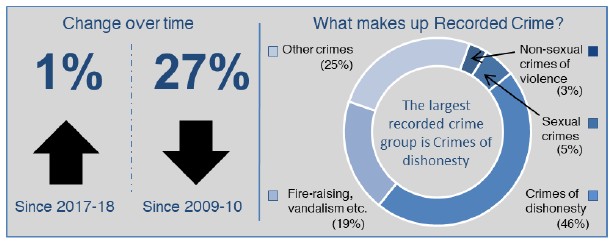
The recording of crime remains at one of the lowest levels seen since 1974. The total number of crimes recorded by the police in Scotland in 2018-19 was 246,480. This is 1% higher than the level recorded in 2017-18 (Chart 1 and Table 6).
Over the past ten years crime has been on a downward trend in Scotland, having decreased by 27% since 2009-10. The small rise in recorded crime this year is set against a generally decreasing trend in recorded crime over the longer term, from a peak in 1991 when crime reached a record high of 572,921.
Chart 1: Total crimes recorded by the police, 1971 to 1994 then 1995-96 to 2018-19 (Table 10)
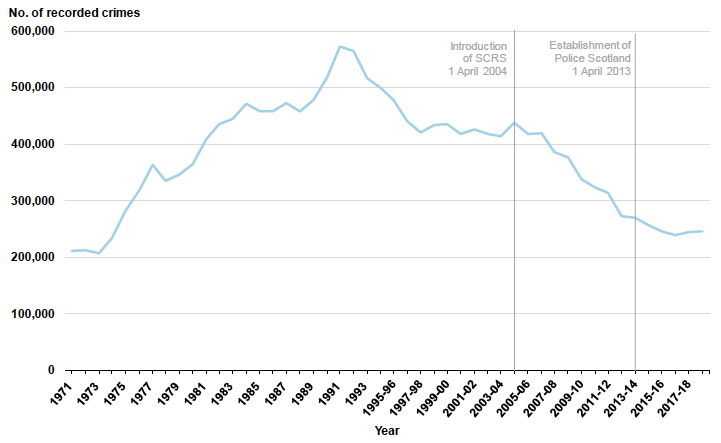
Chart 2 shows the number of recorded crimes in each of the five crime groups since 1971 and gives an indication of the scale of each crime group. Crimes of dishonesty are the largest group, accounting for 46% of all recorded crime in 2018-19. This was followed by Other crimes (25%), Fire-raising, vandalism etc. (19%), Sexual crimes (5%) and Non-sexual crimes of violence (3%). These individual groups will be discussed in more detail in the sections which follow.
Chart 2: Crimes recorded by the police by crime group, 1971 to 1994 then 1995-96 to 2018-19 (Table 10)
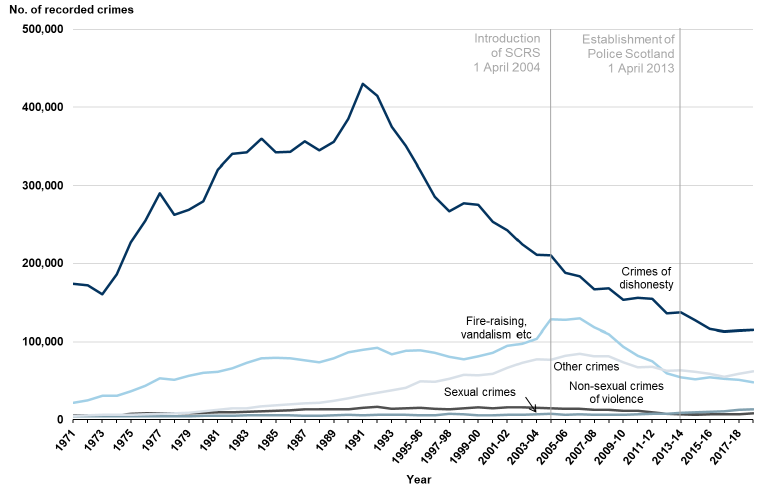
Local Authority analysis:
Nineteen local authorities showed an increase in total recorded crime between 2017-18 and 2018-19.
Five showed very little change, with the remaining eight showing a decrease from the previous year.
Notwithstanding that year-on-year figures can vary across local authorities, the long term trend of decreasing crime is broadly the same across Scotland. Chart 4 shows that since 2009-10 all local authorities show a reduction in recorded crime. This varies from 49% in the Shetland Islands to a much more limited 2% in Dumfries and Galloway.
In 2018-19 the largest number of crimes recorded were in Glasgow City, which includes 12% of Scotland's population but accounted for 18% of all recorded crime in Scotland. It should however be noted that Glasgow's daily population will be higher than its resident population as people travel into the city from surrounding local authority areas for work, leisure and other purposes. Crimes are recorded in terms of where they occur and not the home residency of the victim (where the two places are different locations). The comparison described above for overall crime levels should be viewed in this context – which will also likely apply to Scotland's other city based local authorities.
Further explanation of these trends is set out in the following sections for each crime group. Please note that further local authority level data for Tables 6-8 can be accessed online via the following link: http://www.gov.scot/Topics/Statistics/Browse/Crime-Justice/Datasets/RecCrime
Chart 3: Change in total recorded crime between 2017-18 and 2018-19, by local authority area
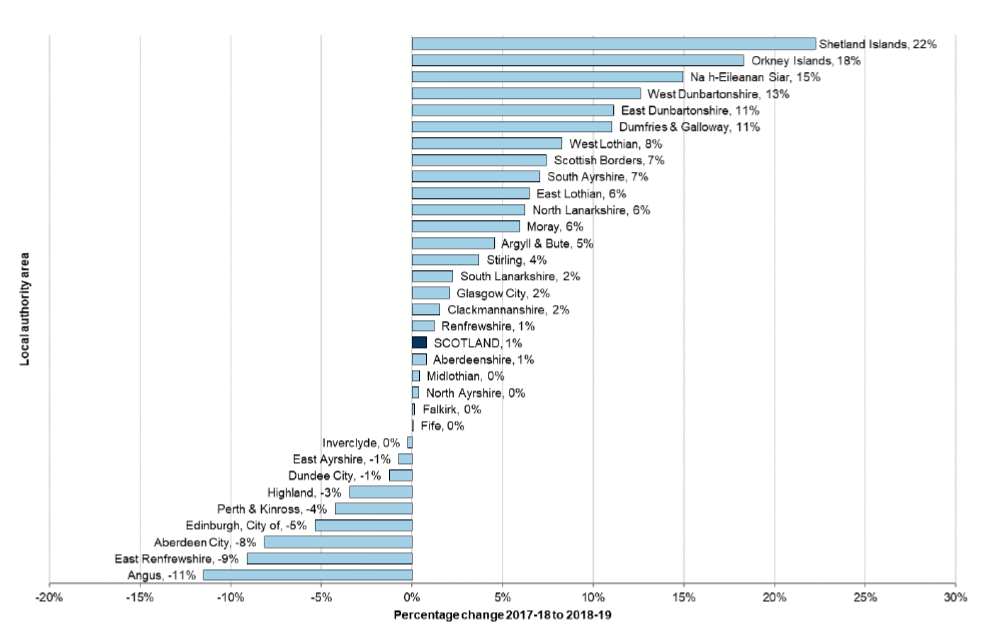
Chart 4: Change in total recorded crime between 2009-10 and 2018-19, by local authority area
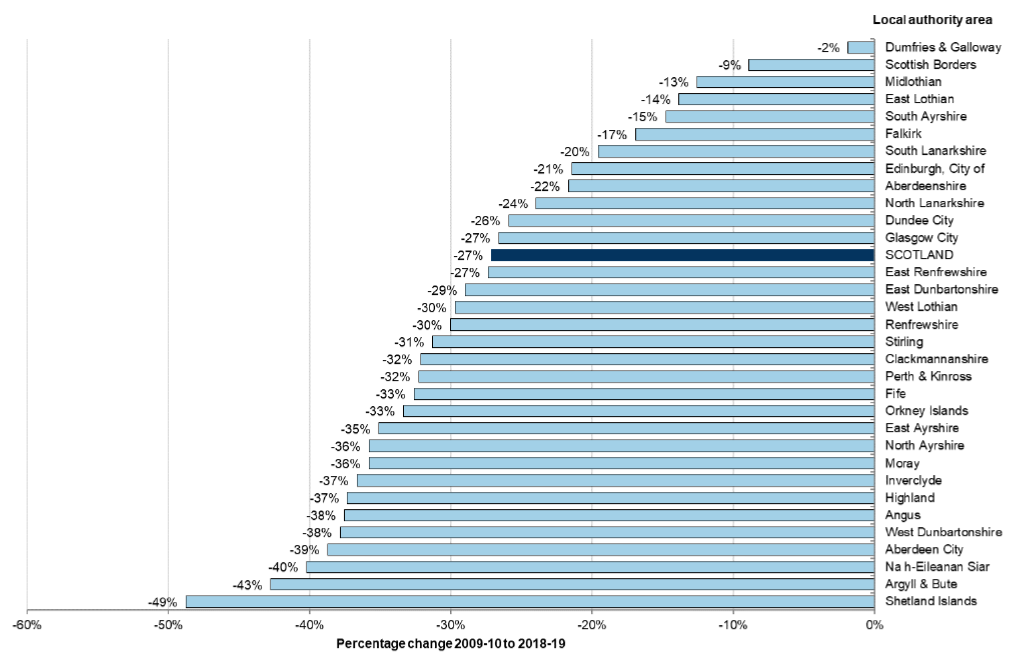
Crime rate per 10,000 population
There were 453 recorded crimes per 10,000 population in 2018-19, with three of Scotland's city based areas recording the highest rates; Glasgow City (717 per 10,000 population), Edinburgh City (604 per 10,000 population) and Dundee City (595 per 10,000 population) (see Table 14 in the Crime and Justice datasets).
Chart 5: Total number of recorded crimes per 10,000 population1, 2018-19
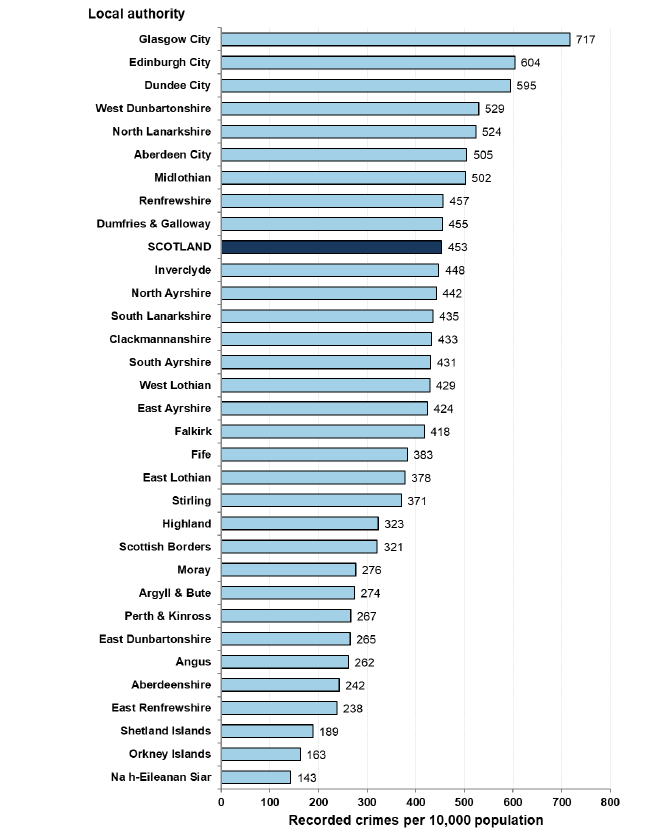
1. Population estimates are as at mid-year 2018 from the National Records of Scotland (http://www.nrscotland.gov.uk/statistics-and-data/statistics/statistics-by-theme/population/population-estimates/mid-year-population-estimates).
Data Considerations
Changes in 2017-18 to the recording of handling offensive weapons
As outlined in Section 2.11, changes in recorded crime in 2017-18 should be treated with some caution due to the addition of newly recorded crimes of handling an offensive weapon. Further information on this procedural change and its impact on the statistics is available in Section 2.11. This change will have an impact on the comparability of recorded crime statistics for all years prior to 2017-18, however the earlier the year selected (for example comparisons with 2009-10) the smaller this will be when set against the long term changes in total crime recorded by the police and other legislative and procedural changes made to the recording of crime during this period.
Data collection process
National Statistics on total recorded crime are based on data which Police Scotland extract from their IT system (called the Scottish Operational and Management Information System (ScOMIS)) and submit to the Scottish Government. Prior to 2013-14 and the establishment of Police Scotland, the Scottish Government collected recorded crime data from the eight legacy forces, who in turn extracted the data from their own systems.
Despite the change in method of collection, the data presented in this section on total recorded crime (which comprises of Crime Groups 1 to 5) remains comparable both before and after 1st April 2013. The Scottish Government produced a Technical Report in 2014 which detailed the quality assurance work it carried out in reaching this conclusion: http://www.gov.scot/Topics/Statistics/Browse/Crime-Justice/PubRecorded Crime/TechnicalReport.
On 1 April 2004, the Scottish Crime Recording Standard (SCRS) was introduced to help maintain a victim orientated approach to crime recording. It was anticipated that this might increase the number of minor crimes recorded such as vandalism and minor thefts. It can be seen from Chart 1 that this did cause a slight increase in 2004-05 as expected, but that the downwards trend returned following this change to recording practice.
Data Validation
HMICS Crime Audit 2016: Background
This bulletin reports on the number of crimes and offences recorded by the police in Scotland. In 2016, Her Majesty's Inspectorate of Constabulary in Scotland (HMICS) published an audit which assessed the extent to which police recording practices complied with the Scottish Crime Recording Standard and Counting Rules: https://www.hmics.scot/publications/crime-audit-2016.
This audit found no systemic data quality issues around the recording of crimes and offences, with the resulting report stating that 'the quality of most incident and crime recording decisions by Police Scotland is good'. 92.7% of incidents were closed correctly[1] and 95.1% of crime was counted and classified correctly.
The report also found that No-criming practice was generally good, with 96.0% of the 876 cases which were initially recorded as a crime but were later re-designated as not being a crime following additional investigation, found to have been no-crimed correctly.
The Audit reported a significant reduction in the proportion of crimes recorded within 72 hours of being reported to the police, from 96.6% in 2014 to 90.8% in 2016. Whist the quality of recording decisions was found to be good overall, it did note evidence that delays in recording have contributed to a reduced level of compliance against the Scottish Crime Recording Standard (investigations can become more complex and detections harder to achieve if significant time has elapsed between reporting a crime and it being recorded by the police).
Non-crime related incidents are those incidents reported to the police which never result in a crime report. Of the 1,138 such incidents examined, 91.0% were closed correctly. This was a statistically significant improvement on HMICS' results for the same category in 2014 (87.2%). The improvement has resulted from increased scrutiny of incidents.
Divisional Results
The Audit report states that there 'are still some significant divisional variations in compliance rates'. Divisional compliance rates for Test 1 (whether an incident was closed correctly) ranged from 87.1% to 98.6% and for Test 2 (whether a crime was counted and classified correctly) from 90.7% to 98.8%.
The Test 1 compliance rate was significantly worse than Scotland as a whole for two of the then 14 divisions; Ayrshire and Renfrewshire & Inverclyde. Four divisions performed significantly better (Dumfries & Galloway, Highland & Islands, Fife and Edinburgh). Furthermore, the no-crime compliance rate in Lanarkshire was significantly worse than Scotland as a whole.
Readers should be aware of these factors when considering information relating to these three divisions, which contain the following local authorities:
- Ayrshire - East Ayrshire, North Ayrshire and South Ayrshire
- Lanarkshire - North Lanarkshire and South Lanarkshire
- Renfrewshire & Inverclyde - Renfrewshire and Inverclyde
Conclusion for the National Statistics and upcoming Audit
Overall, this audit demonstrates that users of crime statistics can have confidence that crimes are being classified and counted correctly. As outlined above, users should be aware that crime statistics for some local authorities will be based on police divisions with lower compliance than the national average. Furthermore, as the audit is based on a sample survey of incident and crime records (rather than all records), the true value may differ slightly from the results in the audit. This is because sampling in this way is subject to a range of quantifiable and non-quantifiable error.
Further details from this audit in relation to compliance rates for specific crime types are provided within the relevant sections of this bulletin and Annex 2 on Quality of the Statistics.
The next HMICS Crime Audit is scheduled to take place in early 2020, where they will again assess the accuracy and timeliness of crime recording by Police Scotland, and the extent to which it complies with the Scottish Crime Recording Standard. Further information about HMICS's future work plan can be found at: https://www.hmics.scot/sites/default/files/publications/HMICS20190329PUB.pdf
Once published, the findings of this audit will be incorporated into the Recorded Crime in Scotland 2019-20 National Statistics bulletin.
Data Comparisons
In addition to the information on police recorded crime, crime in Scotland is also measured by the Scottish Crime and Justice Survey (SCJS), a national survey with adults (aged 16 and over) living in private households which asks respondents about their experiences of crime. Comparisons between recorded crime and the SCJS are included throughout the bulletin where relevant, and further comparison has been made in a specially constructed comparable dataset. Further detail on the comparable crime set is available in Section 5.1[2].
Comparison with Recorded Crime (comparable crime subset):
Of the 602,000 crimes estimated by the 2017-18 SCJS, around 64 per cent (386,000) can be compared with police recorded crimes. Further detail on the comparable crime set is available in Section 5.1.
Both recorded crime figures and SCJS estimates show downward trends in the extent of comparable crime between 2008-09 and 2017-18 (down 40% and 47% respectively). The reduction in estimated SCJS comparable crime from 731,000 in 2008-09 to 386,000 in 2017-18 was a statistically significant change.
Group 1 – Non-sexual Crimes of Violence
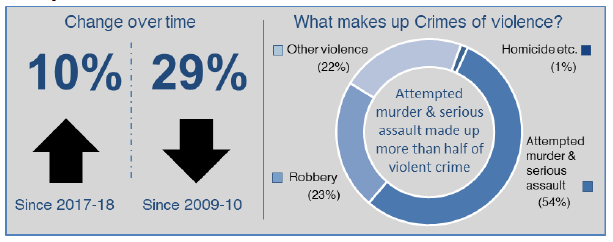
Number of Non-sexual crimes of violence recorded in 2018-19:
Non-sexual crimes of violence account for 3% of all crimes recorded in Scotland in 2018-19. Between 2017-18 and 2018-19, the number of Non-sexual crimes of violence recorded by the police in Scotland increased by 10%, from 7,251 to 8,008.
Chart 6 below shows the number of Non-sexual crimes of violence from 1971 onwards. Levels of violent crime increased for a long period, before entering a downward trend in 2002-03, however there have been increases in the last four years. Despite this Non-sexual crimes of violence have decreased by 50% since 2002-03.
Chart 6: Non-sexual crimes of violence recorded by the police, 19711 to 1994 then 1995‑96 to 2018-19 (Table 10)
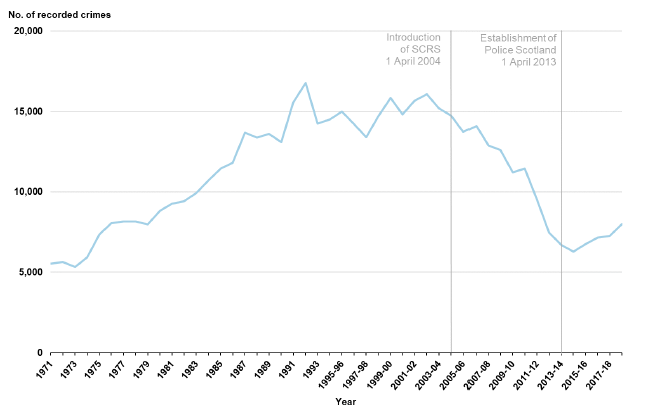
1. Crimes recorded for the present crime groups are not available prior to 1971.
In 2018-19, the national rate of recorded Non-sexual crimes of violence rose to 15 crimes per 10,000 population. This varied by local authority area, with the highest rate in Glasgow City (27 per 10,000 population), and the lowest in the Na h-Eileanan Siar (4 per 10,000 population) (see Table 14 in the Crime and Justice datasets).
Chart 7 shows the four categories within Non-sexual crimes of violence over the last ten years, and gives an indication of the trend and scale of each category. In 2018-19, the volume of recorded crimes of Attempted murder and serious assault made up 54% of all Non-sexual crimes of violence. Crimes of Robbery and Other violence accounted for 23% and 22% respectively of Non-sexual crimes of violence. Homicide etc. continues to contribute a very small proportion (1%) to the total.
Chart 7: Non-sexual crimes of violence in Scotland, 2009-10 to 2018-19
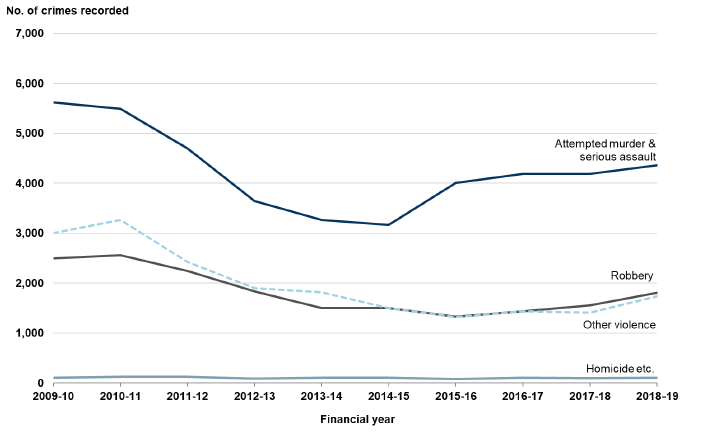
Attempted murder & serious assault:
Attempted murder and serious assault is the largest category in Group 1, accounting for 54% of all Non-sexual crimes of violence. Over the ten year period from 2009-10 to 2018-19, this category has seen a decrease of 22%. These crimes fell between 2008-09 and 2014-15, before figures rose sharply in 2015-16 and then more gradually in the years that followed. This included a 4% increase from 4,189 in 2017-18 to 4,359 in 2018-19. At least part of the increase in 2015-16 has been attributed by Police Scotland to the introduction of enhanced guidance for recording serious assault in January 2015 (see 'Data Considerations' section below).
Twenty of Scotland's 32 local authorities recorded a decrease in this category over the ten year period.
For the definition of Serious assault and the distinction between Serious assault and Common assault please see Paragraph 7.13 within Annex 1.
In addition to these statistics we recently published the findings of a separate study into Attempted murder and serious assault (shortened to serious assault below). This was based on a sample of 1,101 crimes recorded by the police in 2008-09 and 2017-18, the time between which saw the number of these crimes in Scotland decrease by 35% or 2,283 crimes (from 6,472 to 4,189).
The vast majority (89%) of the total fall in police recorded serious assault between 2008-09 and 2017-18 was due to fewer cases in the west of Scotland (centred in and around the city of Glasgow).
All of the fall in serious assault across Scotland came from fewer cases with a male victim, with little change in the number of cases with a female victim. Although the reduction in male victims has driven the total fall in serious assault since 2008-09, they still accounted for 80% of victims in 2017-18.
Most (80%) of the fall in serious assault came from fewer cases where the perpetrator used a weapon, with the study finding that a serious assault in 2017-18 was less likely to involve a weapon than in 2008-09 (dropping from 63% to 55%).
In 2017-18, the use of a knife or other bladed/pointed article to commit a serious assault was much more common in the west of Scotland than elsewhere in the country. There was little difference across Scotland in the proportion of serious assault that involved other types of weapon.
The study also found that the average age of both a victim and perpetrator of serious assault in 2017-18 was several years older than their counterparts from 2008-09. This reflected a particularly large fall in the estimated rate of victimisation for people in their twenties and offending rates for teenagers (aged 13 to 19 years) and people in their twenties.
Finally, the study found that nearly two-thirds (63%) of serious assault committed in 2017-18 included a reference to the consumption of alcohol. This may somewhat underestimate the true position as police officers may not always receive enough information to identify the consumption of alcohol prior to any incident.
Further information is available via the following link: https://www.gov.scot/publications/recorded-crime-scotland-attempted-murder-serious-assault-2008-09-2017-18/
Robbery:
Robbery accounted for 23% of Non-sexual crimes of violence. Over the ten year period from 2009-10 to 2018-19, this crime has seen a decrease of 28%, however there was a 16% increase from 1,556 in 2017-18 to 1,807 in 2018-19.
Seventeen local authorities reported a decrease in this category over the ten year period.
We earlier published the findings of a separate study into Robbery. Further information is available via the following link: https://www.gov.scot/publications/recorded-crime-scotland-robbery-2008-09-2017-18/
Homicide etc.:
As well as Murder and Culpable homicide (common law), the Homicide etc. category included in this bulletin contains the crimes of:
- Causing death by dangerous driving;
- Causing death by careless driving when under influence of drink or drugs;
- Causing death by careless driving;
- Illegal driver involved in fatal accident; and
- Corporate homicide.
Homicide etc. accounted for 1% of Non-sexual crimes of violence. This crime increased by 4% from 98 in 2017-18 to 102 in 2018-19. The biggest contributor to this increase was a rise in driving related homicides (for example Causing death by dangerous driving) which increased by 4 cases, and Murder, which increased by 3 cases. Culpable homicide decreased by 3 cases. There was no change in Corporate homicide, with no cases recorded in 2018-19.
Other non-sexual violence:
The Other violence category includes crimes such as Cruelty to & unnatural treatment of children, Threats & extortion and Abduction, which together account for more than 80% of the crimes within this category. More detail is provided in Chapter 8.
Crimes recorded as Other violence account for 22% of Non-sexual crimes of violence. Over the ten year period from 2009-10 to 2018-19, this category has seen a decrease of 42%, although there was a 24% increase from 1,408 in 2017-18 to 1,740 in 2018-19. This increase was driven by a 26% rise in Cruelty to & unnatural treatment of children from 567 to 717, and a rise in Slavery or forced labour, from 68 to 144. Over the ten year period, all but six local authorities recorded a decrease in this category.
Data Considerations
As noted above, non-sexual crimes of violence increased by 10% between 2017-18 and 2018-19, from 7,251 to 8,008. This reflected increases across the main types of non-sexual violence (including Attempted murder & serious assault, Robbery and Other violence). Increases during the preceding years (2014-15 to 2017-18) were mainly due to a rise in Attempted murder & serious assault recorded by the police.
When HMICS published an earlier audit of crime recording in 2013, they recommended that the definition used for serious assault within the Scottish Crime Recording Standard (SCRS) be reviewed and clarified, as some police officers sought greater clarity from the existing guidance. In response to this, enhanced guidelines as to the interpretation of serious assault were introduced in January 2015.
When publishing their Management Information report for Quarter 4 2015-16 in June 2016, Police Scotland advised that this action may have resulted in some crimes that would have been seen previously as common assaults now falling into the category of serious assault. This in turn may have led to an increase in overall levels of Group 1 non-sexual violent crime in 2015-16 (the first full year following the introduction of enhanced guidelines).
At this stage, complementary sources of information do not report a significant increase in levels of violence, albeit 2018-19 statistics are not yet available for all of them. Police recorded Common assault (covered in more detail under Group 6 Miscelleanous Offences) decreased by 1% between 2017-18 and 2018-19. The Scottish Crime and Justice Survey (SCJS) estimated a statistically significant decrease in violent crime of 46% between 2009-10 and 2017-18, whilst numbers of assault based emergency admissions to hospital fell 55% between 2008-09 and 2017-18 (more detail on these sources is provided below under Data Comparisons).
In addition to this, and as noted above, there was a 26% rise in recorded crimes of cruelty to & unnatural treatment of children between 2017-18 and 2018-19. Further information from Police Scotland suggests this is based on a rise in both recent (recorded less than one year after occurrence) and non-recent cases. The rise in non-recent cases may in part be attributable to the recording of crimes related to the Scottish Child Abuse Inquiry[3].
Data Validation
HMICS Crime Audit 2016
The HMICS Audit report included an examination of violent incidents. It should be noted that in addition to the crimes covered within Group 1 Non-sexual crimes of violence, these incidents also included cases of common assault (the figures for which are contained in this bulletin under Group 6 – Miscellaneous offences). Further information on this audit, including definitions of terminology and tests used, can be found in Annex 2.
Of the 1,693 crimes examined that resulted from violent incidents, 96.0% were counted and classified correctly.
The HMICS audit report notes that whilst classification errors were similar to those found in 2014, there has been improvement in some key areas. For example there were fewer cases in 2016 of more serious violent crimes being classified as less serious, and this may be partly due to extensive work by the crime registrars to ensure serious assaults are not wrongly classified as common assaults. However, it was also noted that the 'errors involving section 38 offences (threatening and abusive behaviour) suggests that this offence might be at risk of being used as a 'catch-all' for violent behaviour'.
Of the 1,986 violent incidents[4] examined in the audit, 93.0% were closed correctly. Test 1 errors for violent incidents generally arose because there was insufficient update on the incident to dispel an initial inference of criminality; there was a lack of follow-up regarding the allegation; the complainer became uncooperative; or the SCRS was misapplied.
Data Comparisons
This segment includes information that should be considered to widen contextual understanding of the data provided on Group 1 - Non-sexual crimes of violence. Detail is provided on a separate homicide bulletin, an analysis of assault-based emergency hospital admissions and the SCJS. Collectively this provides a complementary outlook on violent crime in Scotland.
Homicide
A separate Homicide in Scotland bulletin is produced by the Scottish Government that contains more detailed information on the crimes of Murder and Culpable homicide (common law). The data contained within the Homicide bulletin will differ from the data presented here for the following reasons:
- The Homicide in Scotland bulletin does not cover all of the crimes included within the Homicide etc. category presented in this bulletin, such as causing death by dangerous driving and corporate homicide.
- The data in the Homicide in Scotland bulletin are collected from the police separately to the data presented in this bulletin and are collected on an individual case basis. This allows characteristics of victims and accused, such as age and gender, as well as the circumstances of the homicide, to be collected and then included in the bulletin.
- The data are extracted from police recording systems at different time points, which may result in reclassification of crimes, such as attempted murder to murder, not being revised in the collections for this bulletin, but are reflected in the Homicide in Scotland bulletin.
We therefore recommend that users interested in Homicide statistics should refer directly to the Homicide in Scotland bulletin series, which can be accessed at: http://www.gov.scot/Topics/Statistics/Browse/Crime-Justice/PubHomicide.
The next Homicide in Scotland statistical bulletin will contain data for 2018-19 and will be published on 29th October 2019.
Emergency Hospital Admissions as a result of Assault
As highlighted above, there has been a 22% decrease in the number of attempted murders and serious assaults recorded by the police between 2009-10 and 2018-19, from 5,621 to 4,359. Another source of statistics on assault is ISD Scotland's annual publication on hospital admissions due to unintentional injuries. This includes the number of emergency hospital admissions for assault.
The latest figures (2017-18) are available at: https://www.isdscotland.org/Health-Topics/Emergency-Care/Publications/2019-03-05/2019-03-05-UI-2019-Report.pdf
It is not possible to make direct comparisons between the two sources. Not all cases of police recorded attempted murder or serious assault may include an emergency admission to hospital (treatment might only be required within the Accident and Emergency department or the complainer may not wish to seek medical treatment). Furthermore, not all emergency admissions to hospital for assault may be reported to the police. Depending on the type of injuries sustained by the complainer, some assault-based emergency admissions may be recorded as a common assault rather than a serious assault. However, as these sources both generally relate to how Scotland's emergency services respond to the most serious types of assault, it would be anticipated that both should show similar trends over time.
There were 2,383 emergency hospital admissions as a result of assault in 2017-18, of which 553 were due to assault with a sharp object and 1,843 were other assaults[5]. This represents a decrease of 49% in the total number of emergency admissions due to assault since 2009-10, including a 51% reduction in the number of emergency admissions due to assault with a sharp object. This comparison confirms that the reduction in police recorded crimes of attempted murder and serious assault over the past 10 years has also been broadly reflected in statistics for emergency admissions to hospital. Whilst the reduction in hospital admissions apears to be much larger than that for recorded crime, the change in guidance for crimes classed as serious assaults in 2015 may have had an impact on these figures.
Scottish Crime and Justice Survey (SCJS)
In addition to the information on police recorded crime, crime in Scotland is also measured by the SCJS, a national survey with adults (aged 16 and over) living in private households which asks respondents about their experiences of crime.
It should be noted that violent crime as defined by the SCJS is not directly comparable with Non-sexual crimes of violence recorded by the police. Non-sexual crimes of violence (as used in police recorded crime) includes Homicide, whilst Common assaults (which make up the majority of SCJS violent crime) are included in this bulletin under Group 6 - Miscellaneous Offences. A more detailed examination of comparisons between the SCJS and recorded crime is made within Chapter 5.
Key points from the Scottish Crime and Justice Survey:
Of the 602,000 crimes measured by the SCJS in 2017-18, 172,000 (29%) were violent crimes. It is estimated that 2.3% of adults in Scotland were a victim of violent crime in 2017-18.
In 2017-18, minor assaults resulting in no or negligible injury made up the majority of SCJS violent crime (62%), followed by minor assault with injury (20%), attempted assault (7%), robbery (6%) and serious assault (5%).
Further detail on the comparable crime set is available in Section 5.1. As outlined there and in the Annex of the 2017-18 SCJS, violent crime in the SCJS includes crimes which are included in Group 1 (Non-sexual crimes of violence) and Group 6 (Miscellaneous offences) of the police recorded crime figures.
As outlined in Section 5.1, recorded violent crime figures in the comparable category decreased by 23% between 2008-09 and 2017-18, while for the same period the SCJS estimates of violent crime decreased by 46% (a statistically significant change in the SCJS results).
Group 2 – Sexual Crimes
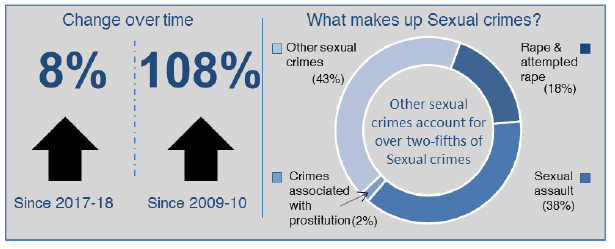
Number of Sexual crimes recorded in 2018-19:
Sexual crimes account for 5% of all crimes recorded in Scotland in 2018-19. The number of Sexual crimes recorded by the police in Scotland increased by 8% from 12,487 in 2017-18 to 13,547 in 2018-19.
Chart 8 below shows the number of Sexual crimes from 1971 onwards. Sexual crimes have been on a long-term upward trend since 1974, and have increased every year since 2008-09. Sexual crimes are at the highest level seen since 1971, the first year for which broadly comparable crime groups are available.
Chart 8: Sexual crimes recorded by the police, 19711 to 1994 then 1995‑96 to 2018-19 (Table 10)
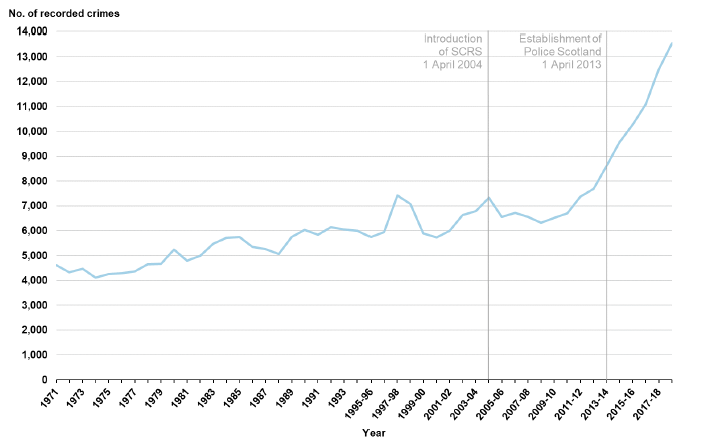
1. Crimes recorded for the present crime groups are not available prior to 1971.
The national rate of recorded Sexual crimes increased from 23 crimes per 10,000 population in 2017-18 to 25 crimes per 10,000 population in 2018-19. This varied by local authority area, with the highest rate in Dumfries & Galloway (36 per 10,000 population), and the lowest in East Renfrewshire (15 per 10,000 population) (see Table 14 in the Crime and Justice datasets).
Whilst the specific age of the victim cannot generally be determined from the data supplied by Police Scotland, many of the sexual crime codes used by the police to record crime make it clear when the victim was aged under 18 (for example, Sexual assault of older male child (13-15 years))[6]. By adding up all these crime codes, we know that at least 39% of the 13,547 sexual crimes recorded in 2018-19 by the police related to a victim under the age of 18. This proportion is similar to the previous year.
Chart 9: Sexual crimes in Scotland, 2009-10 to 2018-19
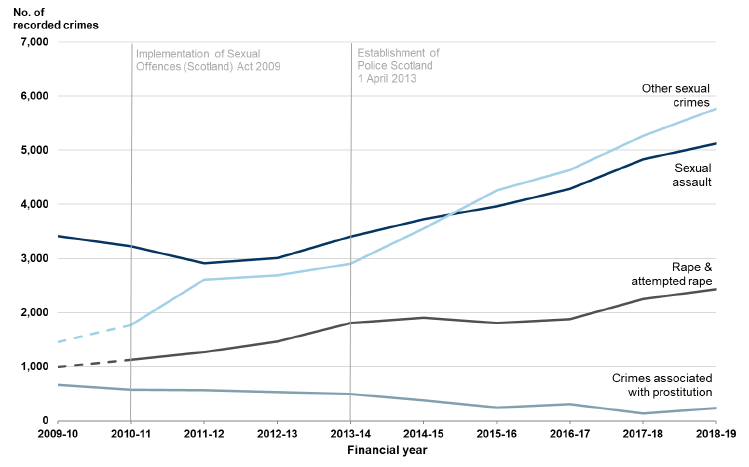
Chart 9 shows the four categories within Sexual crimes over the last ten years, and gives an indication of the trend and scale of each category. In 2018-19, Other sexual crimes made up 43% of all Sexual crimes. Sexual assault and Rape and attempted rape accounted for 38% and 18% respectively of sexual crimes. At just 2%, Crimes associated with prostitution continue to represent a very small proportion of the total.
The number of recorded crimes in the Other sexual crimes and Sexual assault categories have changed markedly over time. They almost converged after 2010, which coincides with the implementation of the Sexual Offences (Scotland) Act 2009, before they both increased during the years that followed up to the present. Information on the impact of the Sexual Offences (Scotland) Act 2009 is available under 'Data Considerations' below.
The proportion of Sexual crimes made up by Other sexual crimes has increased since 2009-10, while the proportion of Sexual assault and Crimes associated with prostitution has fallen. The proportion of Rape and attempted rape has remained fairly constant over time.
Table A1 contains more detailed breakdowns for Sexual crimes.
Sexual assault:
Sexual assault accounted for 38% of Sexual crimes in 2018-19. This category has been on an upward trend since 2011-12, having increased by 76% since that time. This includes a 6% increase from 4,826 in 2017-18 to 5,123 in 2018-19.
The majority (27) of local authorities recorded an increase in Sexual assault since 2009-10 and 18 recorded an increase between 2017-18 and 2018-19.
One of the main drivers behind the increase in Sexual assault between 2017-18 and 2018-19 was a 14% increase in crimes of Sexual assault against an adult 16+, accounting for 93% of the overall increase.
Rape & attempted rape:
It should be noted that due to the implementation of the Sexual Offences (Scotland) Act 2009, comparisons with data prior to 2010-11 should be treated with caution. Additional information relating to the implementation of this legislation is available in the 'Data Considerations' section below.
Rape & attempted rape accounted for 18% of Sexual crimes. There has generally been an upward trend in these crimes since 2010-11 with Rape & attempted rape more than doubling (increasing by 115% overall) between 2010-11 and 2018-19. This includes an 8% increase from 2,255 in 2017-18 to 2,426 in 2018-19. Over half of local authority areas (18 out of 32) recorded an increase in this category between 2017-18 and 2018-19.
Crimes associated with prostitution:
Crimes associated with prostitution account for 2% of Sexual crimes. Over the ten year period from 2009-10 to 2018-19, these crimes have seen a large fall of 64%. There was a 73% increase from 136 in 2017-18 to 235 in 2018-19, however this is the second lowest figure over the last ten years.
The vast majority of these crimes in 2018-19 were recorded in Glasgow City and Aberdeen City.
Other sexual crimes:
The Other sexual crimes category includes crimes such as Communicating indecently; Taking, possessing and distributing indecent photos of children; Sexual exposure, Public indecency and Causing to view sexual images or activity. From 2017-18 onwards it also includes Disclosing or threatening to disclose an intimate image.
As with Rape & attempted rape, it should be noted that due to the implementation of the Sexual Offences (Scotland) Act 2009, comparisons with data prior to 2010-11 should be treated with caution. Further to this, the implementation of the Abusive Behaviour and Sexual Harm (Scotland) Act 2016 has also had an impact on any comparisons with data prior to 2017-18. The Act lead to 421 new crimes of Disclosing or threatening to disclose an intimate image being recorded in 2017-18, with a further 596 in 2018-19. As such, part of the increase in Other sexual crimes since 2016-17 is due to this legislative change. Further information is available in the 'Data Considerations' section below.
Other sexual crimes are the largest category in Group 2, accounting for 43% of Sexual crimes. This category has been on an upward trend since 2010-11, having increased by 226% within that time, including a 9% increase from 5,270 in 2017-18 to 5,763 in 2018-19. All local authority areas recorded an increase in this category over the period from 2010-11 to 2018-19.
The 2016-17 bulletin presented the findings of a research project into Other sexual crimes, based on a sample of around 2,000 crimes recorded by the police in 2013-14 and 2016-17. The research contains details about the victims, perpetrators and circumstances of these crimes.
Where identifiable, the clear majority of victims of Other sexual crimes were female and the vast majority of perpetrators were male. The research also suggests that cyber enabled Other sexual crimes (i.e. where the internet has been used as a means to commit the crime) contributed around half to the total growth in all recorded Sexual crimes between 2013-14 and 2016-17. Those types of crime that have contributed most to the overall increase in Other sexual crimes (Communicating indecently and Cause to view sexual activity or images) are more likely to have younger victims and younger perpetrators where they are cyber enabled, than where they are not. Further information is available via the following link: https://www.gov.scot/publications/recorded-crime-scotland-sexual-crimes-2013-14-2016-17/
Data Considerations
A number of legislative and procedural changes should be kept in mind when reviewing trends in sexual crime over the past ten years.
Sexual Offences (Scotland) Act 2009
The implementation of the Sexual Offences (Scotland) Act 2009 on 1 December 2010 resulted in a redistribution of Group 2 crimes among the subcategories. Comparisons over time of the breakdown of Sexual crimes should therefore be treated with caution.The Sexual Offences (Scotland) Act 2009 widened the definition of rape and therefore comparisons of the category Rape & attempted rape with data prior to 2010-11 should be treated with caution.
There are a number of crimes such as Indecent communication and Voyeurism which may have been recorded as Breach of the peace prior to the implementation of the Act, and which therefore would not have shown up as sexual crimes before December 2010. This coincides with the increase in Other sexual crimes in 2011-12. Therefore, comparisons of the category Other sexual crimes with data prior to 2010-11 should be treated with caution.
Taking, distribution etc. indecent photos of children
In 2010-11, incidents of Taking, distribution etc. indecent photos of children were transferred from Group 6 Miscellaneous offences to Group 2 Sexual crimes. At the time, figures were back-revised to 2009-10. As these incidents accounted for 4% of all Group 2 Sexual crimes in 2018-19, it should be noted that, although figures for this crime have increased over time, a small discontinuity is present in the time series for any analysis that spans 2009-10.
Communications Act (2003) Sexual
In 2017-18, incidents of Communications Act 2003 (Sexual) were transferred from Group 6 Miscellaneous offences to Group 2 Sexual crimes. A review of these cases determined many were similar in characteristic to the type of activity targeted by the new Abusive Behaviour and Sexual Harm (Scotland) Act 2016 and the remainder included incidents of a sexual nature that did not quite fit with the existing definitions covered by the Sexual Offences (Scotland) Act 2009, such as an individual sending the victim a sexual image of themselves. As such, it was decided by the Scottish Crime Recording Board that these offences would be more appropriately classified as sexual crimes within Group 2.
This change involved reclassifying some activity from an offence group to a crime group, and so resulted in a small increase in total recorded crime, with 199 recorded in 2018-19. Statistics for 2016-17 were back-revised within the 2017-18 bulletin, to ensure time series continuity was not affected. There will be some discontinuity for earlier years as the Communications Act 2003 (Sexual) cases were not separately identifiable within the statistics until 2016-17.
Abusive Behaviour and Sexual Harm (Scotland) Act 2016
Finally, the implementation of the Abusive Behaviour and Sexual Harm (Scotland) Act 2016 on 3rd July 2017 resulted in new crimes of Disclosing or threatening to disclose an intimate image being recorded. This has contributed to the increase in Other sexual crimes. Whilst some of these cases may have been recorded as a different crime or offence had they occurred prior to the Act, its likely the clear majority of them would not have been classified as a Sexual crime. It is also the case that the enactment of this legislation extended the criminal law to criminalise certain conduct that previously may not have been illegal.
There were 421 crimes of Disclosing or threatening to disclose an intimate image recorded from 3rd July 2017 to March 2018 and 596 in 2018-19 (the first full reporting year following implementation).
Historical (non-recent) reporting
In addition to the legislative and procedural changes outlined above, the issue of historical reporting of sexual crime also continues to play a role in the latest statistics. Further information from Police Scotland suggests that around a quarter (25%) of sexual crimes in 2018-19 were recorded at least one year after they occurred and that this figure is similar to the previous year. Furthermore, as discussed below the use of specific codes to record sexual crime also highlights where these cases are historical.
Table A1 reports 1,194 crimes of Lewd and libidinous practices in 2018-19. These crimes should all relate to offences which occurred prior to the implementation of the Sexual Offences (Scotland) Act 2009 on 1 December 2010, as the Act replaced Lewd and libidinous practices with specific sexual assault crimes. As a result, we know that these are historical (non-recent) offences. Similarly, there were 288 crimes of Sexual assault committed prior to 1 December 2010.
Furthermore, Police Scotland have cited that increased reporting, including that of historical (non-recent) crimes, may in part be responsible for the increase in recorded sexual crime. The successful outcome of cases featuring historical (non-recent) offending may have highlighted to survivors that cases will be listened to by the police, regardless of how long ago they occurred. Media coverage may also have led to the identification of further survivors who previously may not have reported crimes to the police.
Police Scotland have also highlighted that some investigations can be large-scale involving numerous victims/offenders which span a number of years and can lead to the identification of additional victims/offenders. Online child sexual abuse, which includes grooming/exploitation, has also seen an increase in reporting, not only from victims but concerned members of the public.
Data Validation
HMICS Crime Audit 2016
As previously mentioned, HMICS tested the accuracy of crime recording through auditing a sample of records recorded between 1st January and 31st March 2016. Further information on this audit, including definitions of terminology and tests used can be found in Annex 2.
Of the 914 crimes sampled that resulted from sexual incidents, 91.4% were counted and classified correctly.
As such, the audit noted that 'there remains scope for improvement in the recording of sexual crime'.
Of the 1,117 sexual incidents[7] audited, 90.0% were closed correctly. Incorrect closure in the majority of incidents was due to insufficient information from which to make a judgement as to whether or not a crime had actually occurred. Many of these incidents have been referred to a specialist investigation unit, and while a crime record may be created eventually after what is often a complex and lengthy investigation, it was found that incidents were not updated in the meantime. As a result, HMICS have recommended that 'Police Scotland should embed a 'record-to-investigate' approach to all crime recording in support of a victim-centred service'.
Data Comparisons
This segment includes information that should be considered to widen contextual understanding of the data provided on Group 2 - Sexual crimes. Detail is provided on limited comparisons with recorded crime in England & Wales and Northern Ireland. Further detail on the type of information available from the SCJS on sexual crime is also included.
Comparisons with England & Wales and Northern Ireland
While recorded crime in Scotland is not directly comparable with England & Wales or Northern Ireland due to differences in legislation and counting rules, there is an upward trend for sexual crimes across the UK. Between 2017-18 and 2018-19, sexual crimes in England & Wales increased by 7% compared with 8% in Scotland and 3% in Northern Ireland. In the five years from 2013-14 to 2018-19, sexual crimes in England & Wales increased by 152% compared with 57% in Scotland and 59% in Northern Ireland.
England & Wales detail in their report that the increase in recent years is thought to reflect a greater willingness of victims to come forward to report such crimes, and improvements in police recording practice. Northern Ireland suggest in their report that the increase may in part be due to improved recording of these offences as a result of clarification from the Home Office in relation to the issue of consent, and may be influenced by 'sexting' (when someone sends or receives a sexually explicit text, image or video on their mobile phone, computer or tablet which can include 'sexual chat' and requests for pictures of sexual offences).
Scottish Crime and Justice Survey (SCJS)
Detailed information on the victims of sexual crime is not collected in the main SCJS survey. Information on sensitive topics is collected through a number of additional self-completion sections. Some of these sections include information on sexual crime; for example, the self-completion elements of the 2016-17 and 2017-18 surveys included questions on sexual victimisation, stalking and harassment, and partner abuse. The findings are included in the 2017/18 Main Findings report.
Group 3 – Crimes of Dishonesty
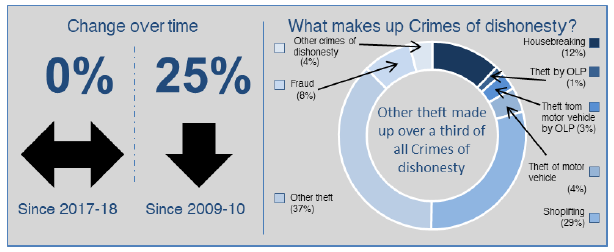
Number of Crimes of dishonesty recorded in 2018-19:
Crimes of dishonesty account for almost half (46%) of all crime recorded in Scotland in 2018-19. Between 2017-18 and 2018-19, the number of Crimes of dishonesty recorded by the police in Scotland was almost unchanged, increasing by less than 1% from 114,474 to 114,506.
Chart 10 below shows the number of Crimes of dishonesty from 1971 onwards. Crimes of dishonesty increased for a long period, peaking in 1991. Since then they have generally reduced, decreasing by 73% up to 2018-19. These crimes are now at their third lowest level since 1971, the first year for which comparable crime groups are available.
Chart 10: Crimes of dishonesty recorded by the police, 19711 to 1994 then 1995‑96 to 2018-19 (Table 10)
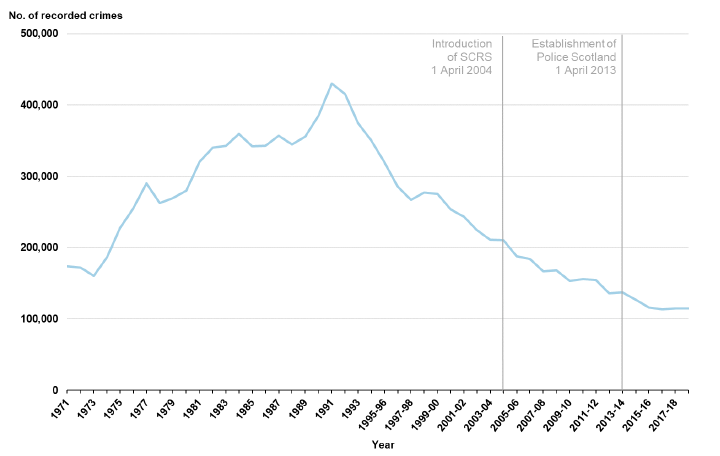
1. Crimes recorded for the present crime groups are not available prior to 1971.
The national rate of recorded Crimes of dishonesty was 211 per 10,000 population in 2018-19, unchanged since 2017-18. Rates varied significantly by local authority area, with the highest rate in the City of Edinburgh (364 per 10,000 population) and the lowest in the Shetland Islands (47 per 10,000 population) (see Table 14 in the Crime and Justice datasets).
Chart 11 shows the four largest categories within Crimes of dishonesty over the last ten years, and gives an indication of the trend and scale of each category. Other theft has consistently been the biggest contributor to Crimes of dishonesty. Other theft and Housebreaking fell by 30% and 42% respectively between 2009-10 and 2018-19. During this same time there were increases in Shoplifting (up 11%) and Fraud (up 17%). While not displayed in Chart 11, the numbers of Theft by opening a lockfast place (OLP), Theft from a motor vehicle by OLP and Theft of a motor vehicle have decreased over the ten years from 2009-10 to 2018-19 (Table 6).
Chart 11: Crimes of dishonesty (showing four largest categories) in Scotland, 2009-10 to 2018-19
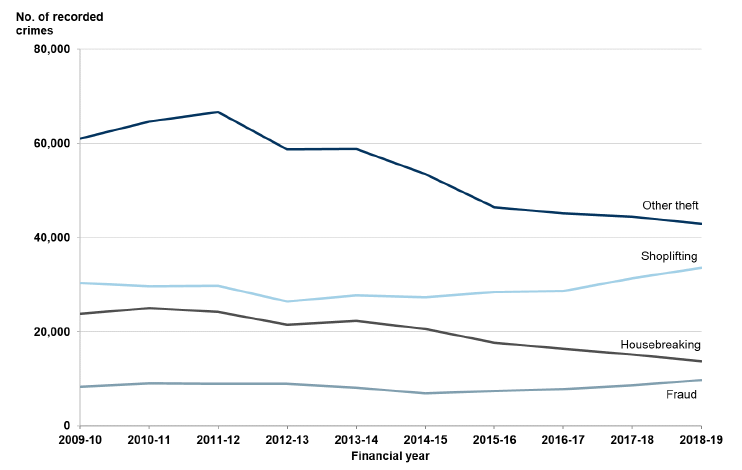
Other theft:
Other theft consists of Theft of pedal cycles, Theft from a motor vehicle not elsewhere classified and Theft not elsewhere classified (excl. motor vehicles).
This category is the largest in Crimes of dishonesty, accounting for 37% of these crimes. Over the ten year period from 2009-10 to 2018-19, Other theft has seen a decrease of 30%, including a 4% decrease from 44,437 in 2017-18 to 42,880 in 2018-19.
All local authorities recorded a decrease in this category over the ten year period.
Shoplifting:
Shoplifting accounted for over a quarter (29%) of Crimes of dishonesty. Shoplifting increased by 7% from 31,321 in 2017-18 to 33,523 in 2018-19. The number of Shopliftings recorded was 11% higher than in 2009-10.
Changes by local authority were varied over the ten year period, with just under two thirds (21) showing an increase in Shoplifting. Similarly, for the change between 2017-18 and 2018-19, 23 of Scotland's local authorities recorded an increase in the number of Shopliftings.
Housebreaking:
Housebreaking accounted for 9% of Crimes of dishonesty. Over the ten year period from 2009-10 to 2018-19 this crime has decreased by 42%, including a 9% decrease from 15,130 in 2017-18 to 13,777 in 2018-19. Table A2 shows that this has been driven by a 12% decrease in housebreaking of domestic dwellings and non-dwellings.
All but one local authority (Scottish Borders) recorded a decrease in this category over the ten year period. Between 2017-18 and 2018-19, over half (18) of local authorities showed a decrease.
Fraud:
Crimes of Fraud account for 8% of Crimes of dishonesty. Despite small fluctuations over the ten year period from 2009-10 to 2018-19, this category has seen an increase of 17%. Numbers increased by 12% between 2017-18 and 2018-19.
Changes by local authority varied significantly over the ten year period, with most showing an increase in Fraud. Between 2017-18 and 2018-19, the majority (23) of local authorities showed an increase.
An Additional Topical Analysis of Fraud, based on a random sample of 500 crime records, is presented at the end of this section.
Theft from a motor vehicle by opening a lockfast place (OLP):
Theft from a motor vehicle by OLP accounted for 3% of Crimes of dishonesty. Over the ten year period from 2009-10 to 2017-18 this crime has seen a large decrease of 65%, including a 5% decrease from 3,734 in 2017-18 to 3,532 in 2018-19.
Most local authorities (27) recorded a decrease in this category over the ten year period. Between 2017-18 and 2018-19, over half (19) of all local authorities showed a decrease.
Theft of a motor vehicle:
Theft of a motor vehicle accounted for 4% of Crimes of dishonesty. Over the ten year period from 2009-10 to 2018-19 this crime has seen a large decrease of 47%, including a 1% decrease from 5,024 in 2017-18 to 4,950 in 2018-19.
All but one local authority recorded a decrease in this category over the ten year period. Between 2017-18 and 2018-19, half (16) of all local authorities decreased.
Other crimes of dishonesty:
Other crimes of dishonesty includes Reset, Corruption, Embezzlement and other crimes of forgery which are not classified elsewhere.
Other crimes of dishonesty account for 4% of total Crimes of dishonesty. Over the ten year period from 2009-10 to 2018-19 this crime has seen a decrease of 16%, however there was a 7% increase from 4,173 in 2017-18 to 4,485 in 2018-19.
All but six local authorities recorded a decrease in this category over the ten year period. 18 local authorities showed an increase between 2017-18 and 2018-19.
Theft by opening a lockfast place (OLP):
Theft by opening a lockfast place (OLP) accounted for 1% of Crimes of dishonesty. Over the ten year period from 2009-10 to 2018-19, this crime has seen a large decrease of 67%, including a 17% decrease from 2,027 in 2017-18 to 1,684 in 2018-19.
All local authorities recorded a decrease in this category over the ten year period. Between 2017-18 and 2018-19, a majority (26) of local authorities showed a decrease.
Data Validation
HMICS Crime Audit 2014
This bulletin primarily uses HMICS's 2016 Crime Audit to provide a quality assessment of crime recording decisions. This latest audit did not sample any incidents relating to Group 3 dishonest crime, as the previous audit in 2014 found compliance in this area to be good. As such, more value was to be gained from testing damage related incidents and crimes - which had not been included in the 2014 Crime Audit.
The 2014 Crime Audit included a specific focus on housebreaking. Of the 1,341 crimes examined that resulted from housebreaking incidents, 95% were counted and classified correctly. The audit report stated that this 'good Test 2 compliance rate reflects the fact that housebreaking incidents appear to be scrutinised carefully by crime management units and are therefore more likely to be accurate' (see page 24 of the 2014 HMICS report for further information).
Of the 1,664 incidents[8] examined, 94% were closed correctly. Around half of the incidents which failed Test 1 did so because the incident record had not been updated with the results of the enquiry and the initial inference of criminality had not been dispelled. A further quarter of Test 1 fails were thought to be crimes where the incident had not been followed up or the complainers had become uncooperative.
Data Comparisons
In addition to information on police recorded Crimes of dishonesty, the Scottish Crime and Justice Survey (SCJS) provides a complementary outlook on some Crimes of dishonesty through asking respondents about their experiences of property crime.
A more detailed examination of comparisons between the SCJS and recorded crime is made within Chapter 5.
Key points from the Scottish Crime and Justice Survey:
Of the 602,000 crimes measured by the SCJS in 2017-18, 430,000 (71%) were property crimes. It is estimated that 11% of adults in Scotland were a victim of property crime in 2017-18.
In 2017-18, vandalism accounted for 38% of property crime, followed by other household theft (including bicycle theft) (29%), personal theft (excluding robbery) (22%), all motor vehicle theft related incidents (6%) and housebreaking (6%).
Further detail on the comparable crime set is available in Section 5.1. As outlined there and in the Annex of the 2017-18 SCJS, the comparable acquisitive crime group in the SCJS includes theft or damage to personal or household property (including vehicles) which are included in a number of recorded crime groups, including Group 3 (Crimes of dishonesty) and Group 4 (Fireraising, vandalism etc).
As outlined in Section 5.1, recorded acquisitive crime figures in the comparable category decreased by 35% between 2008-09 and 2017-18, while for the same period the SCJS estimate showed no change (the apparent reduction of 20% was not statistically significant).
Crimes of Dishonesty: An Additional Analysis of Fraud
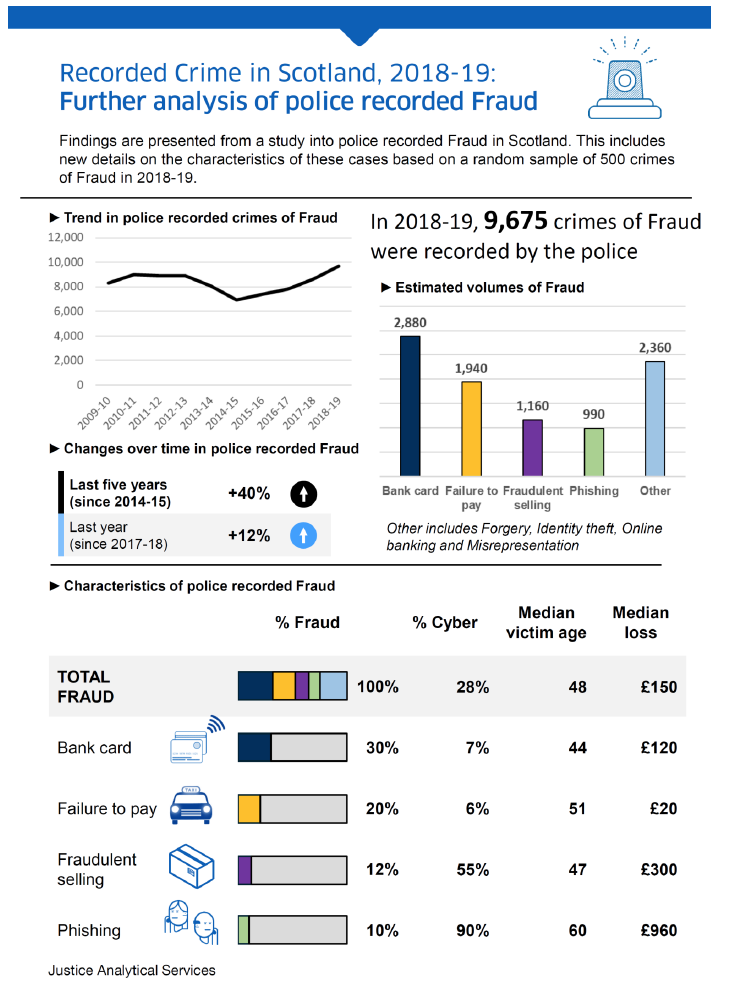
This topical section of the Bulletin presents findings of a study into police recorded fraud in Scotland. This includes new details on the characteristics of these cases, based on a random sample of police recorded crimes.
The information provided below relates to fraud which has come to the attention of the police. It does not provide information on the characteristics of all fraud committed in society, as not all of these crimes are reported to the police. The Scottish Crime and Justice Survey (which includes unreported crime) is unable to provide a robust estimate on the volume of fraud in Scotland, however it does capture some evidence on people's experiences of certain types of fraud. Indicative findings suggest that 5% of adults had their credit/bank card details stolen and 1% had their identity stolen in 2017/18. Looking further afield, the Crime Survey for England & Wales suggested 6.8% of adults were victims of fraud in 2018/19 and that 15% of these incidents were reported to the police or Action Fraud.
Police recorded crimes of fraud increased by 12% between 2017-18 and 2018-19, from 8,628 to 9,675. This was the fourth consecutive increase since 2014-15, when 6,913 crimes of fraud were recorded, representing a 40% increase over that period.
Scottish Government statisticians reviewed a random sample of 500 crimes of fraud from 2018-19, representing 5% of all cases recorded that year. The sample was stratified by Police Scotland division to ensure the prevalence of fraud across the 13 geographic areas covered by those divisions was reflected within the research. Information was recorded about the circumstances of each fraud and the characteristics of the people involved. No personal or sensitive details were collected.
This research is based on a sample of police records (rather than all records), therefore the percentages (proportions) presented in this section are estimates. The true value may differ slightly from the findings presented below due to sampling error. As such users should treat the following analysis as a broad indication of the characteristics of fraud, rather than as an exact measure. All figures are presented at the national level, as sample sizes are too small to provide robust estimates at geographies below this.
There are several methods of calculating an average; in this report the median is used to present the average age of victims and perpetrators (i.e. the age at which half of individuals are older and half are younger). The mean measure of average age can be more influenced by values at the upper end of the distribution (i.e. the older ages) and may not be truly representative of the average age. By taking the middle value of the data, after sorting in ascending order, the median avoids this issue and is consequently considered a better indicator of typical 'average' age. For similar reasons a median measure is also used for the average amount of money defrauded for each case of fraud.
The Scottish Crime Recording Standard (SCRS) notes that it is difficult to give a succinct definition to embrace all the modes of fraud, and as the findings below demonstrate this type of crime covers a wide range of activity. For the police to record a crime of fraud, there needs to be 1) false representation by word of mouth, writing or other false conduct, 2) an intention to deceive and defraud and 3) the wilful imposition by the perpetrator to gaining benefit against the interests of the victim.
Characteristics of Fraud:
An estimated 77% of fraud recorded in 2018-19 had a private individual as a victim, with a further 19% of cases targeted against a business or other organisation (Table 1). Victims were more likely to be male (56%) and had an average age of 48 years old. This compares to an average age for the total population of Scotland of 42 years old in 2018. The average amount defrauded for each crime of fraud was £150. One in six frauds (16%) involved the loss of at least £1,000.
The research estimated that 28% of fraud recorded in 2018-19 was cyber enabled (i.e. the internet was used as a means to commit the crime). The vast majority of victims in these cases were private individuals (93%), with males and females equally likely to be targeted (accounting for 50% of cases each). The average age of a victim was 47 years old, which was similar to where cases weren't cyber enabled (49 years old). At £490, the average amount defrauded for each cyber enabled fraud was around six times higher than where a fraud wasn't cyber enabled (£80). Around one in three (34%) cyber enabled frauds involved the loss of at least £1,000, compared to one in ten (10%) non-cyber enabled frauds.
Fraud by Type of Method:
Police recorded crimes of fraud cover a wide range of actions by the perpetrator. A description of the most common types of fraud committed in 2018-19, as identified through the research, is provided below and in Table 2.
Bank card fraud was the most frequently recorded type of fraud in 2018-19, with an estimated 30% (or 2,880 crimes) of fraud using this method. This typically relates to where a victim's bank card has been used to make a purchase without their knowledge or consent, often using contactless payments. These cases were found to be rarely cyber enabled, where they were this typically involved the perpetrator using the bank card to purchase items online. Bank card fraud was almost exclusively targeted against private individuals. There was little difference in the gender of victims (46% male, 53% female), who had an average age of 44 years old. The average amount defrauded for each crime of bank card fraud was £120.
Failure to pay was the second most frequently recorded type of fraud, accounting for an estimated 20% (or 1,940 crimes) of fraud. This typically relates to where a perpetrator has refused to pay for a product or service they used or agreed to purchase, for example through fleeing the scene when payment was due. Over two-thirds of these cases (69%) relate to unpaid taxi fares (for which this research categorises the victims as 'private individuals' rather than businesses).
The research found that 'failure to pay' type frauds were also rarely cyber enabled (6%), one example of where they were might include an online seller being provided with false evidence of payment before they issued a product to the perpetrator. Just under a quarter (23%) of all 'Failure to pay' type frauds involve the defrauding of a business (for example restaurants and hotels). Most victims were male (88%) and had an average age of 51 years old. The average amount defrauded for failure to pay type-frauds was £20.
Fraudulent selling accounted for an estimated 12% (or 1,160 crimes) of fraud. This typically relates to where a victim has paid for a service or product (either in person or through the internet) that the perpetrator has no intention of providing. This could include through online transactions, or payments to bogus workmen. Just over half of these cases (55%) were estimated to be cyber enabled, and almost all were against private individuals (98%). There was little difference in the gender of victims (53% male, 42% female), who had an average age of 47 years old. The average amount defrauded for fraudulent selling type frauds was £300, with 27% of frauds involving the loss of at least £1,000.
Phishing type frauds accounted for an estimated 10% (or 990 crimes) of fraud. This typically relates to where the perpetrator has obtained sensitive information from the victim (for example banking details) through claiming to be from a reputable organisation. They have then used this information to defraud the victim. Almost three-quarters of these cases (74%) involved a form of 'vishing', whereby the perpetrator phoned the victim to acquire their details. 'Phishing' type frauds were almost always cyber enabled and targeted against private individuals (90% and 94% of cases respectively). Victims were almost equally likely to be male or female (48% male, 52% female), and had an average age of 60 years old. The average amount defrauded for Phishing type-frauds was higher than other methods of fraud at £960, with almost half (47%) of frauds involving the loss of at least £1,000.
Those recorded frauds not included in the four groups above account for an estimated 24% (or 2,360 crimes) of fraud. They cover a wide range of method types – including Misrepresentation (an estimated 7% of all recorded fraud in 2018-19), Identity theft (6%), Online banking (5%) and Forgery (5%).
Misrepresentation relates to where the perpetrator has provided false information for financial gain (for example through seeking refunds for stolen/unpurchased goods). Identity theft is where a perpetrator has used someone else's details to acquire a product or service, such as a loan or credit card. Online banking relates to where the victim has reported seeing fraudulent activity on their online account(s), but this is unlikely to be as a result of a phishing scam or loss/theft of their physical cards. Finally, forgery covers the attempt to pass off fake documents as their genuine equivalents (for example vehicle licence plates, retail vouchers, prescriptions etc.).
Due to the relative infrequency in which these types of fraud appeared in the sample of crime records, robust information on their individual characteristics is not available. Despite this, it is worth noting that all Online banking and many cases of Identity theft were found to be cyber enabled. In contrast, almost all cases of forgery and every case of misrepresentation were not cyber enabled.
Perpetrators of Fraud:
Details of a confirmed or suspected perpetrator were available in 42% of cases. Where a perpetrator was identified by the police, 70% were male and 30% were female. Their average age was 32 years old. Frauds that were not cyber enabled were more likely to include details of a confirmed or suspected perpetrator than those that were (50% versus 21%). There was also some variation in the proportion of frauds that had details of a confirmed or suspected perpetrator by type of method. Bank card (48%), Failure to pay (47%) and Fraudulent selling (43%) type frauds had a much higher proportion of cases with an identified perpetrator(s), than Phishing type frauds (6%).
Summary:
This analysis demonstrates that police recorded crimes of fraud cover a wide range of actions by the perpetrator. The most common types include fraudulent use of a bank card, failure to pay for products or services, fraudulent selling and phishing-type frauds. An estimated 28% of cases were cyber enabled.
The average amount defrauded for each crime of fraud was £150. This was higher for cyber enabled frauds (£490) than for those that weren't (£80). Victims of police recorded fraud were more likely to be male (56%), and had an average age of 48 years old. Victims of phishing-type frauds tended to be older, with an average age of 60 years old.
This research will also contribute to a broader review by the Scottish Crime Recording Board into the guidance used to record criminal behaviour (most likely cyber enabled) where the victim was based in Scotland and the perpetrator was outwith the country at the time they committed the crime or offence. In general these cases are excluded from the recorded crime National Statistics where investigations have confirmed the location of the perpetrator. Users will be kept informed of the outcome of this review and can register for updates on crime statistics through the Scotstat network.
http://www.gov.scot/Topics/Statistics/scotstat
Table 1: Characteristics of crimes of police recorded Fraud, 2018-19, by whether the crime was cyber enabled or not
| Characteristic1 | All Fraud | Cyber enabled | Not cyber enabled |
|---|---|---|---|
| Victim characteristics | |||
| Individual victims2 | 77% | 93% | 75% |
| Male victims | 56% | 50% | 59% |
| Female victims | 42% | 50% | 38% |
| Median victim age | 48 | 47 | 49 |
| Business victims | 20% | 7% | 25% |
| Fraud characteristics | |||
| Cyber enabled | 28% | 100% | n/a |
| Amount involved | |||
| Median loss | £150 | £490 | £80 |
| Loss of at least £1,000 | 16% | 34% | 10% |
| Estimated volume | 9,675 | 2,690 | 6,640 |
1. The above table excludes a small number of frauds which had been no-crimed at the point they were reviewed (i.e. they were no longer recorded as frauds within police crime management systems). This represented 4% of the total sample. For this reason percentages may not always add up to 100%.
2. Percentages for gender of victims may not add up to 100% due to a small proportion of cases where the victim's gender was unknown.
Table 2: Characteristics of crimes of police recorded Fraud, 2018-19, by type of fraud
| Characteristic1 | Bank card | Failure to pay1 | Fraudulent selling | Phishing |
|---|---|---|---|---|
| Victim characteristics | ||||
| Individual victims2 | 95% | 77% | 98% | 94% |
| Male victims | 46% | 88% | 53% | 48% |
| Female victims | 53% | 10% | 42% | 52% |
| Median victim age | 44 | 51 | 47 | 60 |
| Business victims | 5% | 23% | 2% | 7% |
| Fraud characteristics | ||||
| Cyber enabled | 7% | 6% | 55% | 90% |
| Amount involved | ||||
| Median loss | £120 | £20 | £300 | £960 |
| Loss of at least £1,000 | 7% | 1% | 27% | 47% |
| Estimated volume | 2,880 | 1,940 | 1,160 | 990 |
1. Most failure to pay type frauds relates to evasion of taxi fares. In the analysis above, taxi drivers are treated as private individuals rather than businesses.
2. Percentages for gender of victims may not add up to 100% due to a small proportion of cases where the victim's gender was unknown.
Group 4 – Fire-raising, Vandalism etc.
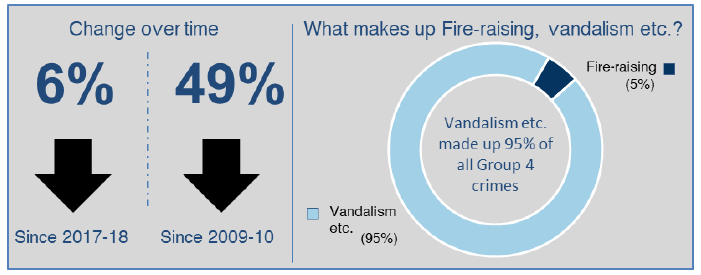
Number of crimes of Fire-raising, vandalism etc. recorded in 2018-19:
Fire-raising, vandalism etc. accounted for 19% of all crime recorded in Scotland in 2018-19. Between 2017-18 and 2018-19, the number of crimes of Fire-raising, vandalism etc. recorded by the police in Scotland decreased by 6%, from 51,322 to 47,997. The recording of these crimes is at the lowest level seen since 1976.
Chart 12 shows the number of crimes of Fire-raising, vandalism etc. from 1971 onwards. Levels of Fire-raising, vandalism etc. increased for a long period, but there was a sharp downward trend since they peaked in 2006-07. Since 2009-10 the number of these crimes has fallen by 49%.
The national rate of recorded crimes of Fire-raising, vandalism etc. decreased from 95 per 10,000 population in 2017-18 to 88 crimes per 10,000 population in 2018-19. Rates varied by local authority area, with the highest in Glasgow City (131 per 10,000 population), and the lowest in Na h-Eileanan Siar (34 per 10,000 population) (see Table 14 in the Crime and Justice datasets).
Due to the difference in scale of recorded crimes of Vandalism etc. and Fire-raising, Charts 13 and 14 show these two categories separately to better highlight the similar downward trends they have followed over the last ten years.
Chart 12: Crimes of Fire-raising, vandalism etc. recorded by the police, 19711 to 1994 then 1995‑96 to 2018-19 (Table 10)
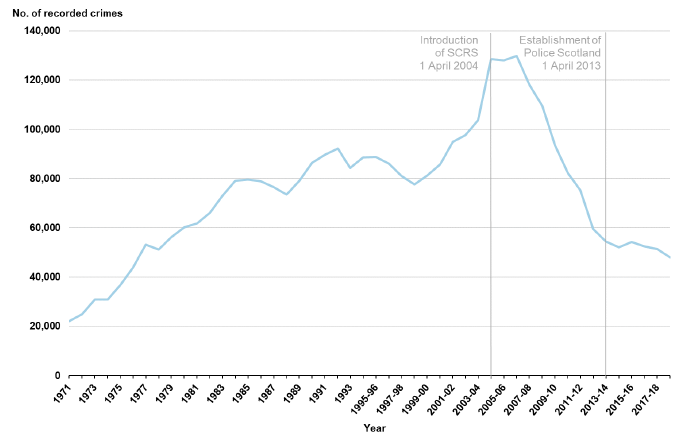
1. Crimes recorded for the present crime groups are not available prior to 1971.
Chart 13: Fire-raising in Scotland, 2009-10 to 2018-19
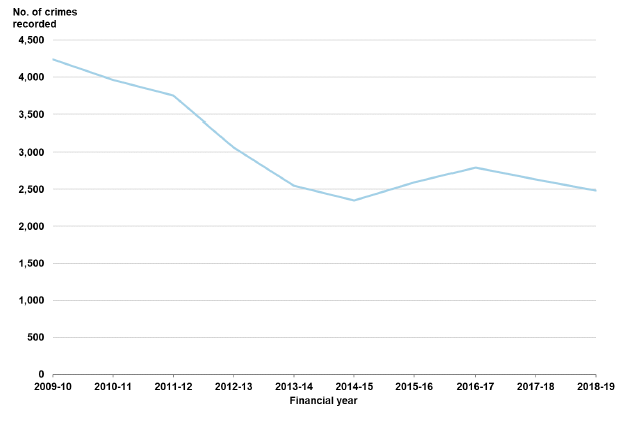
Chart 14: Vandalism etc. in Scotland, 2009-10 to 2018-19
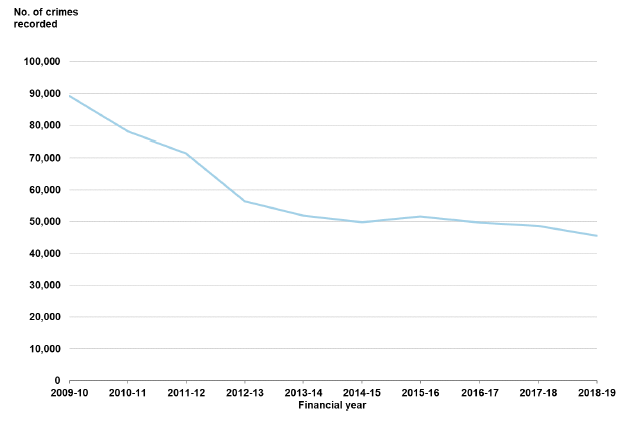
Vandalism etc.:
Vandalism etc. accounted for 95% of crimes of Fire-raising, vandalism etc. These crimes have decreased by 7% from 48,690 in 2017-18 to 45,516 in 2018-19. The longer term trend has also been downwards, with the number of crimes recorded decreasing by 49% from 2009-10 to 2018-19.
All local authority areas recorded a decrease in this category over the ten year period. Between 2017-18 and 2018-19, 20 local authorities showed a decrease in vandalism.
The Vandalism etc. category includes crimes recorded under the Computer Misuse Act 1990. There were 18 such crimes recorded in 2018-19.
Fire-raising:
Fire-raising accounted for 5% of crimes of Fire-raising, vandalism etc. These crimes have decreased by 6% from 2,632 in 2017-18 to 2,481 in 2018-19. Fire-raising has decreased by 42% over the ten year period from 2009-10 to 2018-19.
All local authorities recorded a decrease in this category over the ten year period. Between 2017-18 and 2018-19, 18 out of 32 local authorities showed a decrease.
Data Validation
HMICS Crime Audit 2016
As previously outlined, HMICS tested the accuracy of crime recording through auditing a sample of records recorded between 1st January and 31st March 2016. Further information on this audit, including definitions of terminology and tests used can be found in Annex 2.
Of the 1,938 crimes sampled that resulted from damage-related incidents, 96.0% were counted and classified correctly. Of the 2,032 damage-related incidents[9] audited, 94.9% were closed correctly. Errors in this area were often due to a lack of information to dispel an allegation of criminality, or a lack of follow up with a minor incident not being attended or followed up by telephone.There were also several errors involving non-cooperative complainers, as well as difficulties in re-contacting complainers, which led to incidents being incorrectly closed.
Data Comparisons
This segment includes information that should be considered to widen contextual understanding of the data provided on Group 4 – Fire-raising, vandalism etc. Detail is provided on the number of fires which are attended to by the Scottish Fire and Rescue service, as well as analysis from the Scottish Crime and Justice Survey (SCJS) to provide a complementary outlook on vandalism in Scotland.
Fire and Rescue Statistics Scotland
As highlighted above, there has been a 42% reduction in the number of fire-raising crimes recorded by the police between 2009-10 and 2018-19, from 4,244 to 2,481. Another source of statistics on fire in Scotland is an annual publication covering the number of fires attended by the Scottish Fire and Rescue Service (SFRS). The latest figures (for 2017-18) are available at: http://www.firescotland.gov.uk/about-us/fire-and-rescue-statistics.aspx.
It is not possible to make direct comparisons between the two sources, as many fires are caused accidentally rather than as a result of a crime, and the police are not called to all deliberate fires. Furthermore, not all police recorded crimes of fire-raising may result in the attendance of the SFRS (for example the fire may have ended before the police attended). However as these sources both relate to how Scotland's emergency services respond to fire, it would be anticipated that both should show similar trends over time.
A total of 26,115 fires were attended by the SFRS in 2017-18, of which over 14,800 were started deliberately. This represents a 33% reduction in the total number of fires attended and a 35% reduction in the number of deliberate fires since 2009-10. This comparison confirms that the significant reduction in police recorded crimes of fire-raising over the past 10 years has also been broadly reflected in statistics for the SFRS.
Scottish Crime and Justice Survey (SCJS)
In addition to the information on police recorded crime, the SCJS provides a complementary outlook through asking respondents about their experiences of vandalism in Scotland.
A more detailed examination of comparisons between the SCJS and recorded crime is made within Chapter 5.
Key points from the Scottish Crime and Justice Survey:
As stated earlier, of the 602,000 crimes measured by the SCJS in 2017-18, 430,000 (71%) were property crimes and it is estimated that around 11% of adults in Scotland were a victim of property crime in 2017-18.
In 2017-18, vandalism accounted for 38% of property crime, followed by other household theft (including bicycle theft) (29%), personal theft (excluding robbery) (22%), housebreaking (6%) and all motor vehicle theft related incidents (6%).
Further detail on the comparable crime group is available in Section 5.1 and in the Annex of the 2017-18 SCJS. Vandalism is included in recorded crime figures within Group 4 (Fire-raising, vandalism etc).
As outlined in Section 5.1, recorded Vandalism in the comparable category decreased by 54% between 2008-09 and 2017-18, while for the same period the SCJS estimates of vandalism also decreased by 54% (a statistically significant change in the SCJS results).
Group 5 – Other crimes
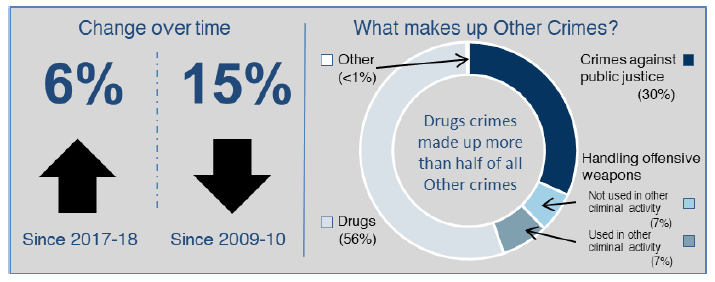
Number of Other crimes recorded in 2018-19:
Other crimes account for one quarter (25%) of all crimes recorded in Scotland in 2018-19. Between 2017-18 and 2018-19, the number of Other crimes recorded by the police increased by 6%, from 58,970 to 62,422.
Chart 15 below shows the number of Other crimes from 1971 onwards. They increased for a long period, peaking in 2006-07. Since then they have generally reduced, decreasing by 27% up to 2018-19. More recently, there has been an increase in Other crimes, from 54,946 in 2016-17 to 62,422 in 2018-19. However almost two thirds of this rise is due to a procedural change in the recording of crimes of handling an offensive weapon (see Section 2.11 for more information).
Chart 15: Other crimes recorded by the police, 1971 to 1994 then 1995‑96 to 2018-19(Table 10)
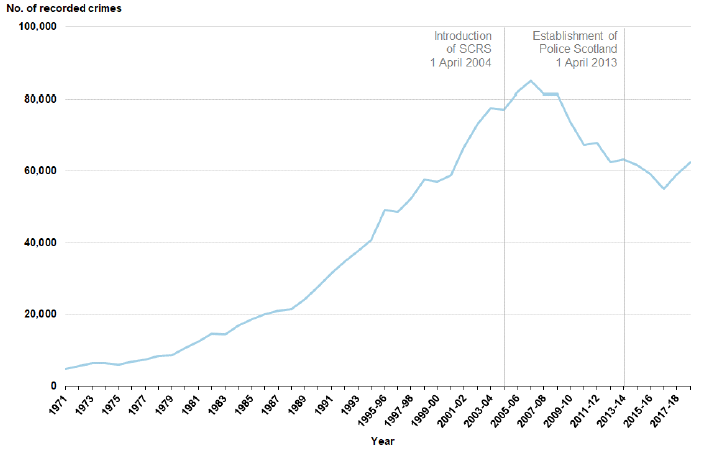
1. Crimes recorded for the present crime groups are not available prior to 1971.
The national rate of recorded Other crimes was 115 crimes per 10,000 population in 2018-19. This varied by local authority area, with the highest rate in Glasgow City (194 per 10,000 population), and the lowest in the Na h-Eileanan Siar (40 per 10,000 population) (see Table 14 in the Crime and Justice datasets).
Chart 16 shows the four categories within Other crimes over the last ten years, and gives an indication of the trend and scale of each category. Drugs crimes have consistently been the biggest contributor, accounting for 56% in 2018-19. A further 30% were Crimes against public justice and 14% were crimes of Handling Offensive weapons.
Chart 16: Other crimes in Scotland, 2009-10 to 2018-19
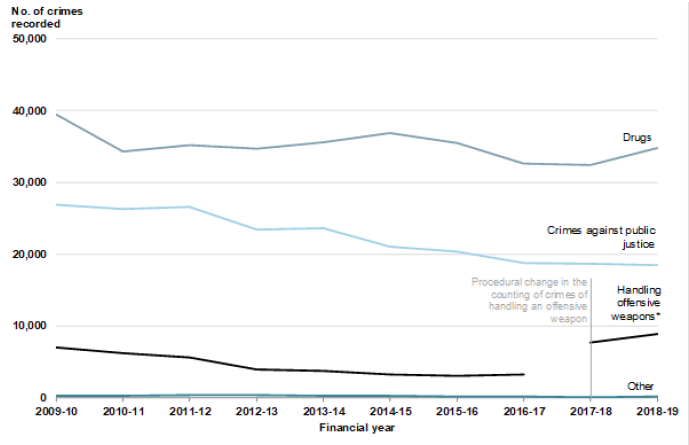
*There was a procedural change to the counting of crimes of Handling an offensive weapon in 2017-18. As such the significant rise in the total number of recorded crimes of Handling an offensive weapon shown for that year, does not represent a real increase in these crimes.
Drugs:
Drug crimes account for 56% of Other crimes. Over the ten year period from 2009-10 to 2018-19 this crime has decreased by 12%, including an 8% increase from 32,399 in 2017-18 to 34,831 in 2018-19.
Over half (18) of local authorities recorded a decrease in this category over the ten year period. Between 2017-18 and 2018-19, around four fifths (25) of local authorities showed an increase.
Crimes against public justice:
Crimes against public justice account for 30% of Other crimes and include Bail offences, Resisting arrest and General attempts to pervert the course of justice. Over the ten year period from 2009-10 to 2018-19 this crime has decreased by 31%, including a 1% decrease from 18,679 in 2017-18 to 18,512 in 2018-19.
Over the ten year period all but four local authorities recorded a decrease in this category.
Handling offensive weapons:
Not used in other crimes or offences
From 2017-18 onwards, crimes of Handling an offensive weapon in Scotland can be counted in two different ways. The first is to use the pre-existing statistics, where the offensive weapon hasn't been used to commit another crime or offence against a person in a public place. These crimes account for 7% of Other crimes in 2018-19.
Over the ten year period from 2009-10 to 2018-19 this crime decreased by 40%. However, there was an 18% increase from 3,570 in 2017-18 to 4,216 in 2018-19, the third year-on-year increase following a prolonged decrease in these crimes.
Over the ten year period, all except four local authorities recorded a decrease in this category. Between 2017-18 and 2018-19, three quarters (24) of local authorities showed an increase.
In 2018-19, 127 crimes of handling an offensive weapon (not used) occurred within a prison and a further 127 occurred within a school. This compares to 99 occurring in a prison and 161 occurring in a school in 2017-18.
Used in other crimes or offences
In addition to the above measure, figures are also available for where the offensive weapon was used to commit another crime or offence against a person in a public place. These crimes also account for 7% of Other crimes in 2018-19. There was a 12% increase from 4,163 in 2017-18 to 4,680 in 2018-19.
In 2018-19, 84 crimes of handling an offensive weapon (used) occurred within a prison and a further 72 occurred within a school. This compares to 42 occurring in a prison and 61 occurring in a school in 2017-18.
In June 2018 a report was published that presented more detailed information on the handling of offensive weapons within public places in Scotland. This included findings on the characteristics of these cases, based on a random sample of 1,500 crimes recorded by the police for the first six months (April to September) of 2013 and 2017.
The overwhelming majority of police recorded crimes for Handling an offensive weapon in a public place were committed by males. When the weapon was not used in other criminal activity the median age of perpetrators was 29 and the majority of crimes involved a knife or other articles with a blade or point.
When the weapon was used in other criminal activity in a public place, the majority of cases involved a male perpetrator and a male victim, who were known to each other and who were both more likely than average to live in urban areas and areas of higher deprivation. In these cases just over half of weapons used were items other than knives or other articles with a blade or point.
The most common criminal act committed with a weapon in a public place was Threatening or abusive behaviour followed by Common assault. In the majority of cases the crime or offence resulted in no physical injury to the victim and this proportion was higher when the victim was female or if the victim did not know the perpetrator. More information can be found by accessing the 'Recorded Crime in Scotland: Handling Offensive Weapons' publication:
http://www.gov.scot/Publications/2018/06/2507
Other:
The Other category within Other crimes includes Treason; Conspiracy; Explosive offences; Wrecking, piracy and hijacking; and Crimes against public order.
This category accounted for less than 1% of Other crimes in 2018-19. Over the past 10 years this type of crime increased by 22% between 2009-10 and 2012-13, and has fallen since then. In 2018-19, the number of crimes recorded was 45% lower than in 2009-10, however there was a 15% increase from 159 in 2017-18 to 183 in 2018-19.
Data Considerations
Drugs:
As outlined above, Drugs crime increased by 8% from 2017-18 to 2018-19. Most of these crimes (86%) are drug possession, where the quantity of drugs seized is small enough to be considered for personal use (as opposed to crimes of drug supply).
Scottish Government statisticians produce an annual statistics release on Drug Seizures and Offender Characteristics. The latest release suggested that a majority (60%) of crimes of drug possession were identified during police patrols or warrant-based searches. As such year-to-year changes in the volume of these crimes could to some extent be due to operational decisions.
One further factor in the growth of recorded drug possession in 2018-19 could be the UK Government's 2017 amendment to the Misuse of Drugs Act 1971, which made it illegal to possess etizolam (a 'designer' benzodiazepine) through classification as a Class C drug. An estimated 1,500 new crimes of etizolam possession were then recorded in Scotland between June 2017 and March 2018 (i.e. the period following enactment). As 2018-19 will be the first full reporting year in which etizolam possession was illegal, it is possible figures could be higher. The next Drug Seizures official statistics bulletin (due in March) will provide further information, including an estimate of recorded crimes of etizolam possession in 2018-19.
Handling Offensive Weapons:
As outlined above, changes in recorded crime in 2017-18 should be treated with some caution due to the addition of newly recorded crimes of Handling an offensive weapon. Further information on this procedural change and its impact on the statistics are available in Section 2.11.
Data Validation
Drugs:
As part of the production process for the above mentioned Drug Seizures and Offender Characteristics bulletin, statisticians reviewed a sample of 400 drug possession crime records from 2017-18. The quality of recording for crimes of drug possession was considered during this exercise and found to be very good, with nearly 100% of the sample classified correctly.
Handling offensive weapons:
Following the decision by the Scottish Crime Recording Board to change the approach to recording crimes of handling offensive weapons in 2017-18 and the impact this was likely to have on the Recorded Crime National Statistics, Scottish Government statisticians undertook a review of crime records to test whether this change had been implemented effectively. As part of a study into the characteristics of weapons crime in Scotland, a random sample of 1,000 crimes of handling an offensive weapon were selected from April to September 2017 (i.e. the first six months following the change to recording practice). The sample was split into the following: 500 crimes of handling an offensive weapon which wasn't used to commit a further crime or offence against a person (shortened to 'weapon not used'); and 500 crimes of using an offensive weapon to commit a further crime or offence against a person (shortened to 'weapon used'). For each crime selected, the record was reviewed to determine if the description of the incident was consistent with the crime assigned to it.
Based on this random sample, 91% of the 1,000 crimes reviewed were correctly classified. For those newly recorded crimes of using an offensive weapon to commit a further crime or offence against a person, the percentage of cases correctly classified was 93%. This suggested that the implementation of new codes to separately identify these cases within the statistics had gone well. For crimes of handling but not using an offensive weapon (i.e. the exisiting measure), the percentage of correctly classified cases was 89%. More information can be found by accessing the 'Recorded Crime in Scotland: Handling Offensive Weapons' publication:
https://www.gov.scot/Publications/2018/06/2507
Using the information gathered as part of this project, statisticians worked with Police Scotland to produce additional guidance that would promote further improvements in recording practice for handling offensive weapons. The guidance was approved by the Scottish Crime Recording Board in February 2019 and added to the Scottish Crime Recording Standard ahead of the 2019-20 reporting year:
http://www.gov.scot/Topics/Statistics/Browse/Crime-Justice/PubRecorded Crime/SCRB/SCRSmanual
Data Comparisons
Drugs
The 'Drug Seizures and Offender Characteristics' bulletin contains more detailed information on the quantities of drugs seized and the characteristics of those who commit crimes of drug possession. Based on a review of 400 drug possession crime records in 2017-18, it was found that the vast majority of drug possession offenders were male and the average age of an offender was 30. Around half of drug possessions involved the seizure of cannabis. More information can be found by accessing the 'Drug Seizures and Offender Characteristics' bulletin:
http://www.gov.scot/Topics/Statistics/Browse/Crime-Justice/DrugSeizures
Total Recorded Offences
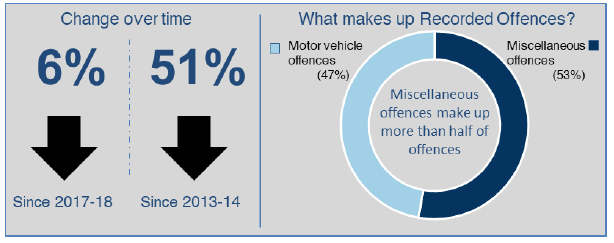
Total number of offences recorded in 2018-19:
Due to anomalies in the data for Motor vehicle offences, statistics for total recorded offences by the police are only comparable from 2013-14 onwards. Further detail on these anomalies can be found in the 'Data Considerations' sections below and in the following sections under each offence group, as well as in Annex 2.
The total number of offences recorded by the police in Scotland decreased by 6% from 264,027 in 2017-18 to 247,791 in 2018-19 (Table 7). This amounts to an overall decrease of 51% since 2013-14.
Miscellaneous offences and Motor vehicle offences account for fairly equal proportions of total offences, compared to 2013-14 when Motor vehicle offences accounted for almost 60% of the total.
Local Authority analysis:
24 out of the 32 local authority areas showed a decrease in recorded offences between 2017-18 and 2018-19. Further explanation of these trends is set out in the following sections under each offence group.
Data Considerations
It should be noted that the number of offences recorded by the police generally tends to be affected more by police activity and operational decisions than the number of crimes.
National Statistics on total recorded offences are based on data which Police Scotland extract from their IT system (called the Scottish Operational and Management Information System (ScOMIS)) and submit to the Scottish Government. Prior to 2013-14 and the establishment of Police Scotland, the Scottish Government collected recorded offences data from the eight legacy forces, who in turn extracted the data from their own systems.
Coinciding with this change of collection, the Scottish Government carried out an extensive data quality exercise to assess the comparability of data extracted from ScOMIS with the data published in previous bulletins. This analysis identified that a number of offence codes are non-comparable over time. For Group 6, Miscellaneous Offences, all data are fully comparable from 2008-09 onwards. For Group 7, Motor Vehicle Offences and hence the overall figures on Offences (based on Groups 6 and 7), data are only comparable from 2013-14 onwards.
The Scottish Government produced a Technical Report in 2014 which detailed the quality assurance work it carried out in reaching this conclusion: http://www.gov.scot/Topics/Statistics/Browse/Crime-Justice/PubRecordedCrime /TechnicalReport.
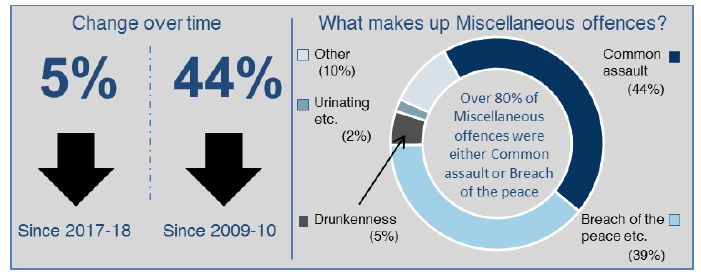
Group 6 – Miscellaneous Offences
Number of Miscellaneous offences recorded in 2018-19:
Miscellaneous offences account for over half (53%) of all offences recorded in Scotland in 2018-19. Between 2017-18 and 2018-19, the number of Miscellaneous offences recorded by the police in Scotland decreased by 5%, from 137,012 to 130,686.
Due to a number of anomalies in the data for Miscellaneous offences, this group is only comparable from 2008-09 onwards. Further information on the comparability of Group 6 is available in the 'Data Considerations' section below, and in Annex 2.
The national rate of recorded Miscellaneous offences decreased from 253 per 10,000 population in 2017-18 to 240 offences per 10,000 population in 2018-19. This varied by local authority area, with the highest rate in Glasgow City (372 per 10,000 population) and the lowest rate in East Renfrewshire (87 per 10,000 population) (see Table 14 in the Crime and Justice datasets).
Chart 17 shows the five categories within Miscellaneous offences over the last ten years. This chart gives an indication of the trend and scale of each category. Common assault and Breach of the peace etc. have consistently been the biggest contributors to Miscellaneous offences.
Chart 17: Miscellaneous offences in Scotland, 2009-10 to 2018-19
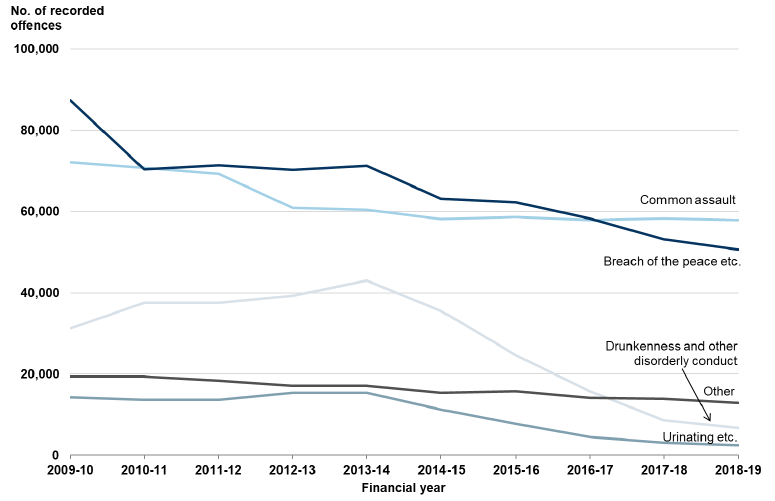
Common assault:
Common assault is the largest category in Miscellaneous offences, accounting for more than two-fifths (44%) in 2018-19. Over the ten year period from 2009-10 to 2018-19, this category has fallen by one fifth (20%), including a 1% decrease from 58,335 in 2017-18 to 57,915 in 2018-19.
All but five local authorities recorded a decrease in this category over the ten year period. Between 2017-18 and 2018-19, just over half (18) of local authorities showed a decrease. For the distinction between Common assault and Serious assault please see Paragraph 7.13 within Annex 1.
The Recorded Crime in Scotland 2015-16 bulletin presented the results of an analysis of police recorded Common assault conducted by Scottish Government statisticians. Based on a review of 500 Common assaults recorded by the police in 2014-15, it suggested that the gender of complainers was equally split between males and females (49% in each case). Perpetrators were more likely to be male or all male groups (74% of cases). It was also found that around half of common assault cases involve no or very little injury to the complainer. The remaining cases (again around half) involve some degree of injury to the complainer. More information can be found by accessing the 'Recorded Crime in Scotland, 2015-16' bulletin:
http://www.gov.scot/Topics/Statistics/Browse/Crime-Justice/PubRecordedCrime
Breach of the peace etc.:
Breach of the peace etc. includes Breach of the peace, Threatening or abusive behaviour, Stalking, Offensive behaviour at football and Threatening communications. A further breakdown of Breach of the peace etc. into its component parts is available in Table A6.
Breach of the peace etc. is the second largest category in Miscellaneous offences, accounting for almost two-fifths (39%) in 2018-19. Over the ten year period from 2009-10 to 2018-19, this category has fallen by more than two-fifths (42%), including a 5% decrease from 53,187 in 2017-18 to 50,708 in 2018-19.
It should be noted that the Offensive Behaviour at Football and Threatening Communications (Scotland) Act 2012, under which offences of offensive behaviour at football and threatening communications are included, was repealed by the Scottish Parliament on 19 April 2018. This has resulted in the number of Offensive behaviour at football and Threatening communications offences falling from 143 in 2017-18 to 4 in 2018-19. However, the driver of the overall 5% decrease in the number of Breach of the peace etc. was fewer offences of both threatening or abusive behaviour (down 1,333) and breach of the peace (down 935) rather than any impact of the repeal.
All but one local authority recorded a decrease in this category over the ten year period. Between 2017-18 and 2018-19, 19 of local authorities showed a decrease.
Drunkenness and other disorderly conduct:
Drunkenness and other disorderly conduct includes offences such as Drunk and incapable, Disorderly on licensed premises and Consumption of alcohol in designated places, byelaws prohibited. For further information on the classification of crimes and offences, please see Chapter 8.
Drunkenness and other disorderly conduct accounted for 5% of Miscellaneous offences in 2018-19. Despite some fluctuation, levels of this offence fell 83% between 2009-10 and 2018-19. This includes a 22% decrease from 8,635 in 2017-18 to 6,724 in 2018-19.
All but one local authority recorded a decrease in this category between 2009-10 and 2018-19. Between 2017-18 and 2018-19, 23 local authorities showed a decrease.
Urinating etc.:
Urinating etc. accounted for 2% of Miscellaneous offences in 2018-19. This category generally increased for several years from 2007-08, peaking in 2012-13. Urinating etc. decreased by 19% from 3,044 in 2017-18 to 2,466 in 2018-19, the sixth consecutive decrease in these offences.
All local authorities recorded a decrease in this category over the ten year period. Between 2017-18 and 2018-19 seventeen local authorities showed a decrease.
Other miscellaneous offences
The Other miscellaneous offences category includes a wide range of offences, including Racially aggravated harassment, Racially aggravated conduct, False/hoax calls, Offences involving children and Offences involving animals/plants. For further information on the classification of crimes and offences, please see Chapter 8.
Other miscellaneous offences account for 10% of Miscellaneous offences in 2018-19. These offences decreased by 7% from 13,811 in 2017-18 to 12,873 in 2018-19.
The majority (25) of local authorities recorded a decrease between 2009-10 and 2018-19. Between 2017-18 and 2018-19, 21 out of the 32 local authorities showed a decrease.
It should be noted that the Other miscellaneous offences category is not considered comparable for years prior to 2008-09. Further information on quality issues is available in the 'Data Considerations' section below, and in Annex 2.
Data Considerations
As outlined in the overall section on police recorded offences, an extensive data quality exercise was carried out to assess the comparability of data extracted from the Scottish Operational and Management Information System (ScOMIS) with data collected from legacy police forces and published in previous bulletins. This analysis identified that all data for Group 6, Miscellaneous Offences, are fully comparable from 2008-09 onwards. However, two offences are non-comparable prior to 2008-09: disorderly on licensed premises (within the Drunkenness and other disorderly conduct category) and control of Pollution (within the Other miscellaneous offences category). Therefore, comparisons for the Drunkenness and other disorderly conduct and Other miscellaneous offences categories in Group 6 should also only be made for 2008-09 onwards. The comparability of the remaining three categories in Group 6: Common assault; Breach of the peace etc. and Urinating etc. are not affected.
The Scottish Government produced a Technical Report in 2014 which detailed the quality assurance work it carried out in reaching this conclusion: http://www.gov.scot/Topics/Statistics/Browse/Crime-Justice/PubRecordedCrime /TechnicalReport.
Data Validation
Scottish Government statisticians reviewed a random sample of 500 common assault records from 2014-15 to develop a better understanding of the nature of this type of offence. The quality of recording decisions for Common assault by Police Scotland is very good, with 98% of Common assaults classified correctly. Those records incorrectly classified as common assault were either a breach of the peace or a serious assault, or insufficient detail was provided to dispel the notion a serious assault had occurred. The full findings and analysis from this sample can be found in the 2015-16 Recorded Crime in Scotland publication.
HMICS Crime Audit 2016
It should be noted that in the HMICS audit report, violent crime includes common assault. Please refer to the Group 1 - Non-sexual crimes of violence section. Further information on this audit, including definitions of terminology and tests used, can be found in Annex 2.
The previous HMICS Crime Audit, carried out in 2014, included a review of Hate Crime. Of the 504 Hate crimes examined, 94% were counted and classified correctly. There were no recurring themes in relation to counting errors for Hate crime. However, the majority of classification errors related to the same technical issue around the classification of crimes between s.50(a) (1B) of the Criminal Law Consolidation (Scotland) Act 1995 and s.38 of the Criminal Justice and Licensing (Scotland) Act 2010.
Data Comparisons
Racially aggravated harassment and conduct
The Other category in Miscellaneous offences contains offences of Racially aggravated harassment and Racially aggravated conduct, and Table A7 shows these offences for the last ten years. In 2018-19 there were 108 offences of Racially aggravated harassment and 1,636 offences of Racially aggravated conduct. While these include specific racially aggravated offences, they do not account for all criminal behaviour which may have had a racial motivation such as Threatening or abusive behaviour or Common assault.
In February 2019 the Scottish Government published the research report 'Developing Information on Hate Crime Recorded by the Police in Scotland' (https://www.gov.scot/publications/developing-information-hate-crime-recorded-police-scotland/). The report provides an update on work by Scottish Government statisticians and Police Scotland to review the availability of information on hate crime recorded by the police in Scotland. It also includes summary information on hate crime recorded by the police, for each of the four years from 2014-15 to 2017-18.
Scottish Government statisticians are continuing to engage with Police Scotland as they develop the information they hold on hate crime. This includes plans for statisticians to review a large sample of police recorded hate crimes to investigate further the characteristics and circumstances of these cases. A report on the findings of this exercise will be published in 2020.
Scottish Crime and Justice Survey (SCJS)
In addition to information on police recorded crime, the SCJS provides a complementary outlook on crimes of violence through asking respondents about their experiences.
As previously noted, violent crime as defined by the SCJS is not directly comparable with Non-sexual crimes of violence recorded by the Police. Common assaults, which make up the majority of SCJS violent crime, are included in the Miscellaneous offences group, and the Non-sexual crimes of violence crime group includes homicide.
A more detailed examination of comparisons between the SCJS and recorded crime is made within Chapter 5.
Key points from the Scottish Crime and Justice Survey:
As stated under the Non-sexual crimes of violence section, of the 602,000 crimes measured by the SCJS in 2017-18, 172,000 (29%) were violent crimes and it is estimated that 2.3% of adults in Scotland were a victim of violent crime in 2017-18.
In 2017-18, minor assaults resulting in no or negligible injury made up the majority of SCJS violent crime (62%), followed by minor assault with injury (20%), attempted assault (7%), robbery (6%) and serious assault (5%).
Further detail on the comparable crime set is available in Section 5.1. As outlined there and in Section 3 of the 2017-18 SCJS, violent crime in the SCJS includes crimes which are included in Group 1 (Non-sexual crimes of violence) and Group 6 (Miscellaneous offences) of the police recorded crime figures.
As outlined in Section 5.1, recorded violent crime figures in the comparable category decreased by 23% between 2008-09 and 2017-18, while for the same period the SCJS estimates of violent crime decreased by 46% (a statistically significant change in the SCJS results).
Group 7 – Motor Vehicle Offences
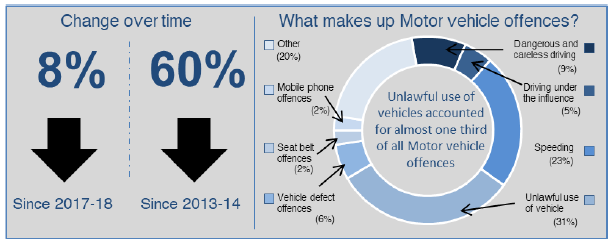
Number of Motor vehicle offences recorded in 2018-19:
Motor vehicle offences account for 47% of all offences recorded in Scotland in 2018-19. Between 2017-18 and 2018-19, the number of Motor vehicle offences recorded by the police decreased by 8% from 127,015 to 117,105. This amounts to an overall decrease of 60% since 2013-14.
Due to a number of anomalies in the data as a result of inconsistencies with legacy data reporting, there is a break in the time series at 2013-14. Further information on the comparability issues can be found in the 'Data Considerations' section below, and detailed information on the comparability of Group 7 is available in Annex 2.
The national rate of recorded Motor vehicle offences decreased from 234 per 10,000 population in 2017-18 to 215 per 10,000 population in 2018-19. This varied by local authority area, with the highest rate in Dumfries & Galloway (545 per 10,000 population), and the lowest in East Dunbartonshire (72 per 10,000 population) (see Table 14 in the Crime and Justice datasets).
Additional information provided by Police Scotland relating to Motor vehicle offences is available in the 'Data Considerations' section below.
Unlawful use of vehicle:
The Unlawful use of vehicle category includes offences such as Driving while disqualified, Driving without a licence, Driving without insurance, and Driving without a test certificate. Further detail can be found in Chapter 8.
Unlawful use of vehicle is the largest category in this group, accounting for just under a third (31%) of Motor vehicle offences. This category decreased by 16% from 43,871 in 2017-18 to 36,848 in 2018-19. Over three-quarters (26) of local authorities recorded a decrease between 2017-18 and 2018-19.
It should be noted that the Unlawful use of vehicle category is not considered comparable for years prior to 2013-14. Further information on quality issues is available in Annex 2.
Speeding:
Speeding accounted for just under a quarter (23%) of Motor vehicle offences. This category decreased by 6% from 29,223 in 2017-18 to 27,368 in 2018-19. This amounts to an overall decrease of 67% since 2013-14. Just over half (19) of local authorities recorded a decrease between 2017-18 and 2018-19.
These figures do not include any offences recorded as a result of the Scottish Safety Camera Programme. These are excluded as no police resources were used in the recording of an offence by this programme and the National Statistics on Recorded Crime focuses solely on crimes and offences faced by the police and not other organisations.
It should be noted that the Speeding category is not considered comparable for years prior to 2013-14. Further information on quality issues is available in Annex 2.
Dangerous and careless driving:
Dangerous and careless driving accounted for 9% of Motor vehicle offences. This category increased by 2% from 10,722 in 2017-18 to 10,989 in 2018-19. Numbers have fluctuated since 2009-10, but the level is currently 5% lower than in 2009-10.
Just over half (17) of local authorities recorded a decrease in this category between 2009-10 and 2018-19. Just under half (15) showed a decrease between 2017-18 and 2018-19.
Vehicle defect offences:
Vehicle defect offences account for 6% of Motor vehicle offences. This category increased by 1% from 7,049 in 2017-18 to 7,107 in 2018-19. This amounts to an overall decrease of 66% since 2013-14. Just over half (18) of local authorities recorded a decrease between 2017-18 and 2018-19.
It should be noted that the Vehicle defect offences category is not considered comparable for years prior to 2013-14. Further information on quality issues is available in Annex 2.
Mobile phone offences:
Mobile phone offences account for 2% of Motor vehicle offences. This category decreased by 9% from 3,173 in 2017-18 to 2,895 in 2018-19. Levels of these offences increased each year from 2009-10, peaking in 2013-14, but have decreased each year since. There has been an overall decrease of 89% since 2009-10 and 92% since 2013-14. All local authority areas recorded a decrease in this category between 2009-10 and 2018-19. Three-quarters (24) showed a decrease between 2017-18 and 2018-19.
Driving under the influence:
Driving under the influence accounted for 5% of Motor vehicle offences. There was little change in this category, decreasing slightly from 5,863 in 2017-18 to 5,847 in 2018-19. Over the longer term, driving under the influence has decreased by 31% as a whole since 2009-10.
All but two (30) local authorities recorded a decrease in this category between 2009-10 and 2018-19. Half (16) showed a decrease between 2017-18 and 2018-19.
Seat belt offences:
Seat belt offences account for 2% of Motor vehicle offences. This category has decreased by 7% from 3,134 in 2017-18 to 2,921 in 2018-19. Levels of these offences had previously been on a generally upward trend between 2009-10 and 2013-14, before decreasing by 92% between 2013-14 and 2018-19.
All local authority areas recorded a decrease in this category between 2009-10 and 2018-19. Just over half (18) showed a decrease between 2017-18 and 2018-19.
Other motor vehicle offences:
The Other motor vehicle offences category includes offences such as Accident offences and Parking offences. Further detail can be found in Chapter 8.
Other motor vehicle offences account for 20% of Motor vehicle offences. This category decreased by 4% from 23,980 in 2017-18 to 23,130 in 2018-19. This amounts to an overall decrease of 45% since 2013-14. Just under two-thirds (21) of local authority areas recorded an increase between 2017-18 and 2018-19.
It should be noted that the Other motor vehicle offences category is not considered comparable for years prior to 2013-14. Further information on quality issues is available in Annex 2.
Data Considerations
As outlined in the overall section on police recorded offences – an extensive data quality exercise was carried out to assess the comparability of data extracted from the Scottish Operational and Management Information System (ScOMIS) with data collected from legacy police forces and published in previous bulletins. This analysis identified that due to the standardisation of reporting practices following the establishment of Police Scotland, there are significant comparability issues for Group 7 Motor Vehicle Offences. There are no issues for two of the categories in Group 7: Dangerous and careless driving and Driving under the influence. Seat belt offences and Mobile phone offences are only comparable back to 2008-09. The other categories in Group 7, and hence the overall figures for Group 7, are only comparable back to 2013-14.
The Scottish Government produced a Technical Report in 2014 which detailed the quality assurance work it carried out in reaching this conclusion: http://www.gov.scot/Topics/Statistics/Browse/Crime-Justice/PubRecordedCrime /TechnicalReport.
In relation to the overall decrease in Motor vehicle offences, Police Scotland have cited their move towards engagement and education to prevent road offences in addition to enforcement, with raising awareness and high profile media campaigns designed to influence driver behaviour and public attitudes. Further, Police Scotland state that high-risk road traffic offender groups are identified and targeted as part of routine business, and Anti-Social Behaviour legislation is used proactively, through the issue of initial warnings to drivers/vehicles followed by seizure of the vehicle where relevant.
More specifically, the number of Vehicle Excise Licence Offences recorded decreased from 3,792 in 2017-18 to 176 in 2018-19. This was largely due to standardisation of practice across Police Scotland divisions in November 2017, whereby the Driver and Vehicle Licensing Agency (rather than the police) took primacy in dealing with these offences.
Contact
Email: JusticeAnalysts@gov.scot
There is a problem
Thanks for your feedback